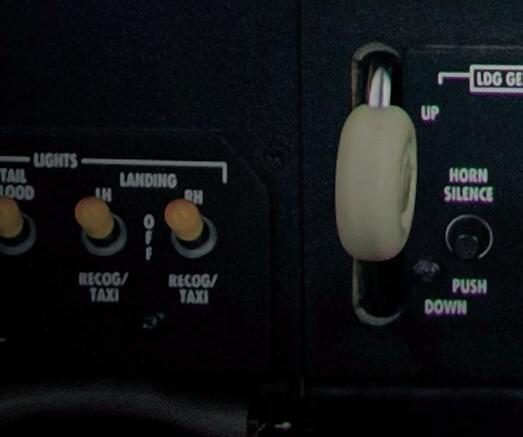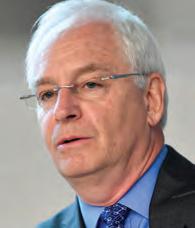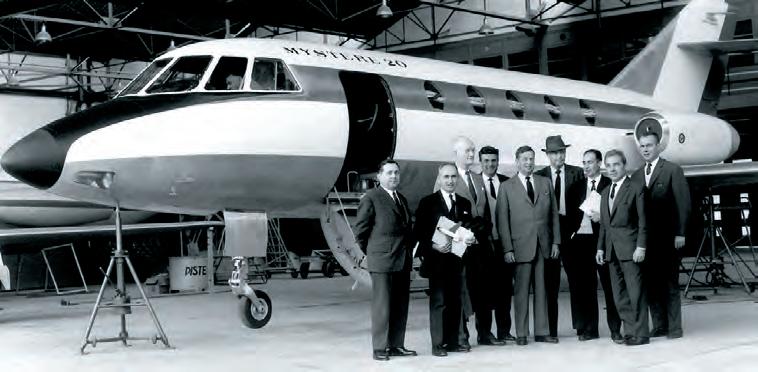SANCTIONS: BIZAV NAVIGATING RUSSIAN RESTRICTIONS
COVID: THREE YEARS LATER, A PANDEMIC RETROSPECTIVE
TECHNOLOGY: BATTERIES WILL CONSTRAIN THE FUTURE
Special Report: FBO Survey EMEAA
Launch of a Legend
With the heritage and handling of a fighter jet, the Falcon 20 ushered in a new era in business aviation

AVIATION INTERNATIONAL NEWS MAY 2023 | Vol. 52 No. 5 | AINonline.com $9.00











LARGER JET TECHNOLOGY SMALLER CARBON FOOTPRINT The only midsize with full fly-by-wire and Active Turbulence Reduction +1 321 751 5050 | embraer.com/praetor500
40 U.S. struggles with sustainable Li-ion battery supply chain
20 Special Report: 2023 FBO Survey: EMEAA

4 Daher plans production increase, hybrid-electric TBM
6 NTSB releases alert on the risks of circling approaches
8 Helicopter business leaders open the door to eVTOLs

10 Bizjets sustain two fatal accidents in first quarter
12 Adjusting to a new normal without Russia
30 Covid meets business aviation —a post-pandemic review
18 Legacy Tails–Falcon 20: Je suis une légende

28 After years of accidents, ‘clear of clouds’ remains murky
38 Geared Up: Garmin D2 Mach 1 aviation watch DEPARTMENTS
Aviation International News \ May 2023 \ ainonline.com 2
issue
In this
44 Avionics | 46 Rotorcraft | 50 On the Ground 52 Maintenance | 54 Accidents | 56 Compliance 58
in
People
Aviation
CITATION MODE: ENGAGED
GFC™ 600 AVAILABLE NOW FOR SELECT CITATION JETS
FULLY COUPLED VERTICAL NAVIGATION*
INTEGRATION WITH GARMIN NAVIGATORS AND FLIGHT DISPLAYS










MODERN, PATENTED, SMART

BRUSHLESS SERVOS *With compatible Garmin navigator and flight instruments or flight display (sold separately). © 2023 Garmin Ltd. or its subsidiaries. All rights reserved.
News Briefs
FLEXJET SCRAPS IPO, CONTINUES GROWTH PLANS
Flexjet on April 11 scrapped plans to go public through a combination with SPAC Horizon Acquisition Corp. II. In October, the fractional ownership provider announced the agreement to go public with Horizon with the expectation that the transaction would conclude by mid-2023 and result in proceeds to help fund fleet, program, and geographic expansion. Flexjet chairman Kenn Ricci, however, said the company believes the decision to terminate was in the best interests of customers, employees, and stakeholders, and stressed that the move would have “no impact on growth initiatives.”
Daher plans production increase, hybrid-electric TBM
BY CHAD TRAUTVETTER
By 2027, Daher’s aviation division expects to broaden its product lineup with a hybrid-electric TBM and set up a third aircraft production facility in Stuart, Florida, Daher aviation division senior v-p Nicolas Chabbert told AIN at the Sun ‘n Fun Aerospace Expo in April. The company produces four models— the Kodiak 100 Series III and 900 and TBM 910 and 960—and delivered 73 airplanes last year and estimates 85 to 90 this year.
The additional production line will be located at Daher’s aerostructures facility in Stuart. Combined with Kodiak production in Sandpoint, Idaho, and TBM manufacturing in Tarbes, France, the Stuart facility will make both lines and boost total annual output to 120 to 130 airplanes.
That ancillary capacity will be needed as Daher plans to add a fifth aircraft model—a hybrid-electric version of the TBM influe nced by its EcoPulse technology demonstrator, which is being developed in partnership with Safran and Airbus. According to Chabbert, the hybrid-electric EcoPulse had logged 10 hours to date with two of its six electric motors installed. Testing thus far has been focused on thermal issues.

Flight testing of the demonstrator is set to resume in its current four-motor configuration. By June, the EcoPulse will have all six motors installed before making its public debut at this year’s Paris Airshow.
Chabbert said Daher is evaluating the motor configurations in stages to guide the development of a production hybrid-electric aircraft, which he expects will enter service in 2027. z
AMSTERDAM SCHIPHOL AIRPORT PLANS BIZJET BAN
Amsterdam Schiphol Airport intends to ban private jets and small business aircraft starting in 2025 as part of a wider strategy to reduce noise and carbon dioxide (CO2) emissions. According to the Dutch airport operator, business aviation flights cause a “disproportionate amount of noise nuisance and CO2 emissions per passenger.” But EBAA noted that “banning business aviation at Schiphol can lead to a significant loss of income for the Dutch economy, while the CO2 savings [would be] minimal.”
NBAA TO FAA: CONTINUE REMOTE TOWER AT LEESBURG
NBAA appealed to the FAA to continue remote tower operations at Leesburg Executive Airport in Northern Virginia until an alternative can be developed. Since 2015, Leesburg airport has used a system that relays operations data captured via cameras and other technologies to a remote tower center outside the airport. However, the FAA has opted to discontinue its use. NBAA president and CEO Ed Bolen maintained that the Saab-developed remote tower system has provided both safety and cost benefits.
Aviation International News \ May 2023 \ ainonline.com 4
Daher expects to bring a hybrid-electric TBM to market in 2027 that is influenced by the EcoPulse.
Sun ‘n Fun 2023

For 11,500 Part 91 operators, CAA membership means more savings, more freedom, and more control. We negotiate the best jet fuel prices from more than 275 preferred FBOs throughout the US and beyond. You even get to vote on which FBOs we include — and recommend your favorites. Interested FBO? Sign up online. JOIN FOR FREE TODAY! Visit www.corpaa.us CAA provides the lowest price on jet fuel offered to Part 91 aircraft at the CAA Preferred FBO. SAVE 30% ON AVERAGE. TRY IT FOR 3 MONTHS FREE. Wherever You Fly, We Are Where You Fuel.
NTSB releases alert on the risks of circling approaches
BY KERRY LYNCH
ACSF Safety Symposium
The National Transportation Safety Board (NTSB) has released a safety alert advising on the risks and preparation necessary to perform circling approach procedures and maneuvering. The alert, “Circling Approaches: Know the Risks,” was released as the NTSB has been preparing a report on its investigation of the July 2021 Bombardier Challenger 605 accident in Truckee, California, that involved an unstabilized circle-to-land approach. In addition, the Safety Board released the alert to coincide with the Air Charter Safety Foundation’s (ACSF) Safety Symposium in late March.

Board member Michael Graham, among the slate of speakers at the ACSF event, cited the Truckee accident—as well the May 2017 Learjet 35A crash in Teterboro, New Jersey, and the December 2021 Learjet 35A accident at Gillespie Field in El Cajon, California—in the development of the safety alert.
News Briefs
DASSAULT AVIATION ADDS SAF AT LITTLE ROCK FACILITY
Dassault Aviation has added a continuous supply of sustainable aviation fuel (SAF) at its Little Rock completions facility at Bill and Hillary Clinton International Airport (KLIT) in Arkansas. The fuel, supplied by Avfuel and refined by Neste in a 30 percent SAF blend, is being used for all Falcon customer acceptance and departure flights from the facility. Use of the green fuel at this site is part of the SAF plan implemented by Dassault to reduce the carbon footprint of its aviation operations. Under this plan, all flights operated by company-owned Falcons are being flown using SAF blends.
CAE OPENS U.S. WEST COAST BIZAV TRAINING CENTER
In the alert, the NTSB noted that since 2008, 10 accidents involving Part 91 and 135 operators have occurred during a circling approach and have resulted in 17 fatalities. These approaches can be riskier because they require maneuvering at low altitude and low airspeed, increasing opportunity for loss of control or collision with terrain, according to the Safety Board.
Further, circle-to-land maneuvering often results in an unstabilized approach and, while sometimes necessary, pilots don’t always evaluate the risks before accepting them, it added.
The safety alert advises operators to fully understand the risk involved, consider their own experience and limitations such as weather and runway configuration, and know that they may be able to request alternatives. Further, the NTSB recommends scenario-based training in realistic environments for such approaches and stresses the need for a comprehensive briefing before performing such an approach. z
Worldwide flight training provider CAE cut the ribbon early last month for its newest training center near Las Vegas Harry Reid International Airport. The 50,000-sq-ft facility is the company’s first on the U.S. West Coast. Seven of the facility’s eight simulator bays are already filled, representing the Bombardier Global 7500; Gulfstream G650, G550, GV, and GIV; and Embraer ERJ-145 and Phenom 300E. The latter is the seventh Phenom simulator deployed globally as part of the Embraer CAE Training Services joint venture. The center will train more than 2,500 pilots annually, according to CAE.
AVIC FLIES AC332 HELICOPTER
China-state-owned aircraft manufacturer Avic’s light-twin-engine AC332 helicopter achieved first flight on April 7 in Tianjin. The 12-seat AC332 features a four-blade main rotor system and ducted tail rotor and is designed for hot-and-high operations. It is powered by a pair of 1,800shp Avic WZ-20 engines. Performance targets include an 8,487-pound mtow, 374-nm range, 140-knot maximum cruise speed, and 19,685-foot service ceiling.
Aviation International News \ May 2023 \ ainonline.com 6
The Challenger 605’s flight path near Truckee-Tahoe airport.
THE GULFSTREAM DIFFERENCE
Your mission is our inspiration. Every investment we make—in advanced technology, precision manufacturing and worldwide customer support—is an investment in you.

News Briefs
EASA STAFF FLIES LEONARDO AW609 TILTROTOR
Helicopter business leaders open the door to eVTOLs
BY CHARLES ALCOCK
Rotorcraft industry leaders addressing the March Helicopter Investor conference in London expressed measured optimism over prospects for the emerging advanced air mobility (AAM) sector. There was consensus that new eVTOL aircraft will start t o be used for some current helicopter use cases, albeit most speakers expressed doubt that this will start happening from 2025, as many market entrants are insisting.
Lobo Leasing is one of a handful of lessors to have committed to adding eVTOL aircraft, having already made a down payment for Pipistrel’s planned Nuuva autonomous cargo vehicles.
Olivier Piot, CEO of Nova Capital— which in March launched a €50 million ($54 million) private debt fund for light helicopters—said his company has no plans to invest in eVTOLs. However, he conceded that their market debut could impact rotorcraft residual values.

Bristow is investing in an AAM future and has provisional order agreements in place with seven manufacturers, including Electra, Beta Technologies, Elroy Air, Vertical Aerospace, Eve Air Mobility, Overair,
and Lilium. CEO Chris Br adshaw suggested that early eVTOL use cases could be in South America and Africa and focused on remotely piloted cargo flights.
“There will be a role for startups but also for mature operators like us,” he told the conference. “We have a dozen different AOCs and employ more than 800 pilots and about the same number of maintenance technicians. We also have experience managing operations in unregulated airspace in places like Surinam, where there is nothing [in terms of infrastructure].”
Blade Urban Air Mobility is also working on plans to bring eVTOLs into its network of on-demand operating partners. The U.S. company went public in 2021 and its president and general counsel, Melissa Tomkiel, said its main focus will be building air-taxi and medical services in existing markets such as the New York City metro area, the south of France, and India.
“We believe eVTOLs can address community noise concerns [about helicopters] and that will hopefully unlock new landing infrastructure,” she told conference attendees. z
EASA certification pilots flew the Leonardo AW609 civil tiltrotor in Italy in mid-March as part of its first round of familiarization activities for the aircraft program. These flights follow FAA pre-type inspection authorization flights on February 22 in Philadelphia. Leonardo said both sets of flights constitute “an important step forward in the final stages of the certification process” and set “the right pace on the validation process, together with the FAA certification path.” Meanwhile, three customer AW609s are now in final assembly.
ATLANTIC COMPLETES INTEGRATION OF HAWAII FBOS
Atlantic Aviation has completed the rebranding and integration of six former Air Service Hawaii FBO locations into its network. The locally-owned chain was purchased last year by Ross Aviation, which later merged with Atlantic. The newly-branded locations are at Honolulu Daniel K. Inouye International, Maui Kahului, Kona Ellison Onizuka Kona International, Lihue, Hilo International, and Lanai airports. Later this year, Atlantic will complete construction of an FBO complex at Kona with a 5,000sq-ft terminal and a 38,000-sq-ft hangar.
GULFSTREAM OPENS BEVERLY HILLS SALES/DESIGN CENTER
Gulfstream Aerospace has expanded its presence on the U.S. West Coast with the opening of a sales and design center in Beverly Hills, California. The 12,000-sq-ft facility is designed to provide customers with a firsthand look at the cabins and finishings of the Gulfstream fleet as they make completion and finishing decisions to tailor aircraft to their mission requirements. The center showcases cabin mockups of Gulfstream’s G400, G700, and G800 living areas, as well as the seat designs of the G500 and G600.
Aviation International News \ May 2023 \ ainonline.com 8
Lobo Leasing intends to add Pipistrel’s Nuuva family of eVTOL cargo vehicles to its portfolio.

Bizjets sustain two fatal accidents in first quarter
BY GORDON GILBERT
The safety picture for the first quarter of this year was marred by fatal accidents involving two U.S.-registered business jets and three turboprops that took the lives of 16 crew and passengers, compared with zero business jet fatals and three turboprop fatals that claimed 12 souls in the first quarter of 2022.
News Briefs
BOSE UNVEILS A30 HEADSET
According to AIN research, preliminary data shows all but one of the fatal events for both quarters occurred under Part 91.
On Jan. 2, 2023, an Embraer Phenom 300 crashed after the pilot lost control during takeoff from Provo, Utah, on a planned Part 91 flight.
continues on page 60
Bose has introduced the A30 as its latest active noise-reduction (ANR), over-the-ear aviation headset. Retailing for $1,249, the A30 is slightly lighter than the $1,195 A20 it replaces and offers lower clamping pressure and digital ANR features similar to those in the ProFlight 2 in-ear headset. The A30 is also FAA TSO approved—which some airlines and operators require for headsets used by their pilots. The digital chipset in the A30 ANR runs all the time, but Bose engineers were still able to maximize battery life to more than 45 hours. Bose’s ProFlight series was the first to get the digital chipset, but the A30’s chipset is more advanced.
WASHINGTON WITHDRAWS FROM FAA CHIEF NOMINATION
Phil Washington, the CEO of Denver International Airport and now-former embattled nominee to become the next FAA Administrator, withdrew from consideration in late March. President Joe Biden initially nominated Washington to the post in July and reupped his nomination in January after the new Congress session began. Republicans in both the Senate and the House raised objections over his aviation experience. Also clouding the nomination was an ongoing corruption probe stemming from Washington’s time as CEO of the Los Angeles County Metropolitan Transportation Authority.
FLEXJET EXPANDS HELICOPTER OPERATIONS TO EUROPE
All Data Preliminary. * For example: air ambulance, aerial survey, ferry, training, testing, manufacturer, government (non-military). Sources: FAA, NTSB, Aviation Safety Network, AIN research
that range from minor damage to destruction and/or injuries. Also, some incidents ultimately get upgraded to accident status during the investigative process.
Flexjet has added a Sikorsky S-76 helicopter to its European fleet, which also includes Leonardo AW109s and AW169s. The service, initially focused on the UK, follows a similar launch last year by the company in the Northeast U.S. and Florida. Flexjet is offering helicopter programs as a standalone service and as an extension to its existing private jet owners as an enhancement of its Gulfstream G650 program in Europe.
Aviation International News \ May 2023 \ ainonline.com
ACCIDENTS/INCIDENTS WORLDWIDE (1Q/2023 VS 1Q/2022) U.S.-registered Business Jets and Turboprops Business jets TotalPart 91Part 91KPart 135 Public/Gov’t Mfg 20232022 20232022 20232022202320222023202220232022 Total accidents 646100030000 Nonfatal accidents 444100030000 Fatal accidents 202000000000 Fatalities 202000000000 Incidents 23161410 00960000 Business turboprops TotalPart 91Part 91KPart 135Public/Gov’tMfg 202320222023202220232022202320222023202220232022 Total accidents 886700210000 Nonfatal accidents 554400110000 Fatal accidents 332300100000 Fatalities 1412 9 12 00500000 Incidents 15161011 00441100 AIN
ACCIDENTS/INCIDENTS WORLDWIDE (1Q/2023 VS 1Q/2022) Non-U.S.-registered Business Jets and Turboprops Business jets TotalPrivateCharterOther*Unknown 2023202220232022 202320222023202220232022 Total accidents 0401030000 Nonfatal accidents 0404030000 Fatal accidents 0000000000 Fatalities 0000000000 Incidents 5 16 1 10 460000 Business turboprops TotalPrivateCharterOther*Unknown 2023202220232022202320222023202220232022 Total accidents 7 11 22560201 Nonfatal accidents 5 10 22360101 Fatal accidents 2100200100 Fatalities 3100300100 Incidents 8835311111
tables show “incidents” as well as “accidents” to distinguish mishaps based on their degree of severity. Investigators often draw fine distinctions between the two events, but, typically, incidents result in minor or no damage and their investigations are sometimes delegated to local officials. Accidents are events
10
Falcon | Citation | Gulfstream | Learjet | Hawker | Challenger | Global Express | Embraer | Conquest weststaraviation.com Strong Roots, Healthy MRO CAPABILITY • • INNOVATION • RESOURCES • QUALITY DEDICATION • EXPERIENCE • NLA • GJT • CHA • PCD • PWK • APA • CXO • PSM
Adjusting to a new normal without Russia
BY KATE SARSFIELD
Russia’s invasion of Ukraine in February 2022 and the subsequent, ongoing sanctions on the country—designed to weaken President Vladimir Putin’s war economy and his cabal of influential oligarchs—has almost completely sealed off Russian aviation, both business and commercial.
This previously steady market has been devastated, with original equipment manufacturers (OEMs) stopping the sale and supply of air craft and components. The sanctions have made it impossible to trade, service, and support an aircraft with links to a Russian entity anywhere in the world.
Notams, meanwhile, ban Russianregistered aircraft and those types known to be owned or operated by Russian nationals—whatever their connection to Moscow—from entering European airspace or landing in many countries.
Less than a decade ago, Russia was regarded as one of the great emerging markets for business aviation, along with the likes of China, Brazil, and India—known as the BRIC countries.
The ostracization of Moscow has certainly had an effect on the ability of oligarchs to travel the world for business and
pleasure, although many popular destinations in North Africa and the United Arab Emirates still remain open to them. Sanctions, however, and the effective shuttering of a swathe of European airspace is having repercussions on the industry as a whole—to what extent is still open to debate.

Traditionally, the Russian market accounts for around 2 percent of new aircraft sales each year, largely in the super-midsize, large-cabin, long-range, and VIP airliner categories, according to Robert Baltus, chief operations officer for the Eur opean Business Aviation Association (EBAA). “Obviously these orders cannot be honored in the current climate, but thanks to the bullish market, there is no shortage of buyers to take their place.”
STRONG MARKET
Baltus’s view is echoed by aviation analyst Rolland Vincent. “There are ample customers more than willing to gobble up any available delivery positions, often at higher prices due to the restricted supply of aircraft in today’s marketplace,” he said.
Vincent described the current marketplace as “exceptionally tight” with order backlogs of more than two years, unprecedented pricing strength, and very limited availability of quality preowned aircraft. “While inventories of for-sale aircraft have been trending upwards, the market remains a seller’s paradise—for now,” said Vincent.
According to market research company Amstat, around 150 business aircraft are registered in Russia, down slightly from 167 a year ago. The majority of Russian-owned and -operated models are registered outside of the country and are estimated to numbe r around 400 units—2 percent of the global fleet and 5 percent of the

Aviation International News \ May 2023 \ ainonline.com 12
Vnukovo FBO in Moscow during better days when business jet travel to Russia was relatively free of constraints.
ROLLAND VINCENT ANALYST
inventory of super-midsize to ultra-longrange jets—although it is opaque as to how many are still operating today.
It is also unclear how many business jets with links to Russia have been seized and grounded to date, with some observers putting the tally at a couple of dozen in Europe alone. This includes a pair of private jets owned by sanctioned Russian billionaire Eugene Shvidler: a Bombardier Global 6500 (r egistration LX-FLY) impounded at London- ar ea Farnborough Airport on March 9, 2022, along with a Cessna Citation Latitude impounded at Biggin Hill. Their seizure followed the introduction by the UK government of a law making it a criminal offense to handle an aircraft that has any connection to Russia through registration or ownership, management, and charter.
The restrictions, largely mirrored throughout Europe, Canada, and the U.S.,

THE PERFECT PLACE FOR BUSINESS AIRCRAFT

ainonline.com \ May 2023 \ Aviation International News 13 www.amacaerospace.com
Leaving an aircraft in the spot where it was seized had a lot of unintended consequences from a health and safety, fire, operational, logistical, and even environmental perspective.
ROBERT BALTUS COO, EBAA
include a rule that aircraft seized must be grounded with immediate effect and remain untouched.
This ruling has been greeted with frustration by the industry, Baltus noted, with many seeing it as a blunt tool. “Leaving an aircraft in the spot where it was seized had a lot of unintended consequences from a health and safety, fire, operational, logistical, and even environmental perspective,” Baltus noted. “Furthermore, if that sanctioned air craft is parked in front of your hangar door and you’re not allowed to move it, you can’t run your business. So, who are rules hurting in that case?”
SANCTION SANITY
The EBAA has been in “constant dialogue” with the European Commission (EC), Baltus noted, to ensure that its members are fully complying with the sanctions, “which can be difficult to navigate.”
The Brussels-based association along with other concerned industry groups secured clarifications from the Commission and the UK government to allow seized aircraft not owned by Russian nationals on the sanctioned list to be stored in a protection plan, to allow the engines to be turned intermittently to prevent corrosion.

Baltus stressed, however, that this is only a “basic” concession and depends on the interpretation of the 27 EU member
states and the U.S. sanctions. There is no figure to date on the number of impounded aircraft that are stored in a protection plan and what condition they are in, but the Commission has made it “very clear,” Baltus conceded, that anything that helps retain the residual value of the sanctioned aircraft “is not acceptable.”
For aviation lawyer Aoife O’Sullivan, this position is regrettable.

“There’s a lot of beautiful equipment, multi-million-dollar assets in many cases, that cannot be serviced or even sold on, and that is such a pity,” she said.
O’Sullivan, partner of London-based The Air Law Firm, suggested the far- reaching nature of the sanctions and notams is heavy-handed.
“So, you’re not a sanctioned individual, you’re not living in Russia, you don’t support Putin or the regime, yet you’re left with a pretty asset sitting on the ramp that you can do nothing with. It’s unfair,” she said.
O’Sullivan is calling on Europe’s lawmakers to collaborate with the industry to find a practical solution. “If you don’t want Russian owners to own aircraft, please just work with us to get them sold to people who want them and can use them. Nobody is gaining by leaving the assets on the ground,” she said.
If there are any positive repercussions for the industry from the sanctions, O’Sullivan argues it is the increase in transparency and an acquiescence to the increased level of scrutiny. The mantra “know your customer” (KYC) is now common parlance, said O’Sullivan. “Due diligence was often resisted and greeted with accusations of ‘you are asking too many questions.’ Now there is a general acceptance that clients
Aviation International News \ May 2023 \ ainonline.com 14
Relatively few purpose-built business jets are registered in Russia, and some of them are older models like this Hawker 700.
AOIFE O’SULLIVAN PARTNER , AIR LAW
There’s a lot of beautiful equipment, multi-million-dollar assets in many cases that cannot be serviced or even sold on, and that is such a pity.
VLADIMIR KARNOZOV
must share their information because companies won’t take any risks in the current climate of there being even a hint of a connection to Russia.”
KNOW YOUR CUSTOMER
Her claim is supported by TAG Aviation, one of Europe’s largest business aviation charter and management companies, whe re KYC is embedded in the company culture.

“Russian nationals or anyone with links to Russia cannot be the principal passenger on a charter or have anything to do with the payment of the flight,” said TAG Aviation chief commercial officer Karl Mills.
While the rules may seem clear-cut, it can often be tricky to follow the money trail. “If there is a hint of doubt as to the identity of the principal passenger, we won’t accept the booking. The stakes are far too high,” said Mills.
To illustrate his point, Mills cites the case of Emperor Aviation. The Maltese operator was sanctioned by the U.S. Office of Foreign Assets Control last November— along with eight related business jets—for conducting travel on behalf of the family of sanctioned oligarch Suleiman Kerimov.
TAG Aviation’s zero-risk approach to the sanctions led to it terminating a handful of aircraft management contracts with customers with links to Russia. While a blow to these owners, the Geneva, Switzerland-headquartered firm had no difficulty replacing the lost business, thanks to a surge in postCovid-pandemic travel, which, according to Mills, has cushioned any financial impact from the shuttered Russian market.
“Leisure flights boomed as travelers— many first-time entrants to business aviation—opted for private jets rather than commercial airlines, which they viewed as unreliable and less Covid-safe,” said Mills.
TAG Aviation’s business continues to thrive. This success is driven partly by the many first-timers making a permanent switch to private aviation, he noted, but also b y the long-awaited return of
KARL MILLS CHIEF COMMERCIAL OFFICER, TAG AVIATION

the corporate travel market late last year and TAG Aviation’s recent expansion into the cargo, medical evacuation, and MRO niches. “We learned in the early days of the pandemic that your business is built around moving passengers and if they can’t fly, you have to diversify and spread the risk,” said Mills.
This includes expanding its geographical reach. With the Russian market now
sealed off for the foreseeable future, TAG Aviation is eying ventures in Asia, Australia, and the Middle East, he added.
TAG Aviation’s diversification strategy is shared by VistaJet, the Malta-headquartered high-end charter provider and one of Europe’s largest operators with a multimodel Bombardier fleet.
The company’s shift over the last decade from a largely Europe-centered to a global business aviation company has helped to minimize the collapse in the Russian market on its balance sheet, according to VistaJet chief commercial officer Ian Moore.
“The Russian market represented less than 5 percent of our customer base when the sanctions hit,” he noted. “A decade ago, that would have been a far larger percentage, because Russia, largely driven by luxury consumer-driven customers, had a deep footprint inside the European industry,” Moore conceded.
ainonline.com \ May 2023 \ Aviation International News 15
The closure of the Russian market was evident for the first time at the start of the year, Moore suggested, with the loss of the traditional Orthodox Christmas holiday traffic. “You didn’t have that second or third week of flying in January that you usually have, and coupled with a softening of the charter market during the s ame period, the impact was noticeable,” he noted.
CONSERVATIVE APPROACH
Like TAG, VistaJet has taken a “very conservative” approach to the sanctions. “If the re is any grey area with a customer or a booking, we go to the highest level as the risks are enormous both financially and reputationally,” said Moore.
The last thing the private aviation industry needs, he admitted, is the optics of doing things that other people could not do.
While some of VistaJet’s Russian customers have been able to adapt to the sanctioned environment by using up their committed charter hours outside the restricted regions, others have not. “Obviously some customers cannot fly so we have worked with them to suspend their
commitment going forward in return for a small fee,” said Moore. “There’s a big cost to us because we carry all the fixed costs,” he added.
Moore describes the timing of the sanctions as “fortunate” for the European private aviation market. “There was enough business in the mark etplace for several more months, so Russia coming out of the market didn’t have a significant impact on anyone who was truly European as opposed to those who were Eastern European with a focus on the Russian client base,” he said.
Czech business aviation services provider ABS Jets said the Russian market r epresented 20 percent of its business before the war began. Jan Kralik, chief


executive of the Prague-headquartered firm, said the impact of the sanctions was felt by its handling, operations, and MRO divisions, where the Russian and Ukrainian markets “always played a significant role before the war.”

Aviation International News \ May 2023 \ ainonline.com 16
Russian FBOs can still do business, but only with Russian companies and customers flying in sanction-free areas.
JAN KRALIK CEO, ABS JETS
If there is any grey area with a customer or a booking, we go to the highest level as the risks are enormous both financially and reputationally
IAN MOORE CHIEF COMMERCIAL OFFICER, VISTAJET
Thanks to Europe’s buoyant business aviation sector, ABS has successfully plugged the gap, snapping up contracts in new markets and adding five managed jets to its fleet. “As always, every crisis brings opportunities,” said Kralik.

Of course, the sanctions are not onesided. Russia in retaliation introduced harsh restrictions on NATO and EU members, closing its vast airspace to all aircraft registered in these countries.
Typically, Russia accounts for a small percentage of global traffic, said EBAA’s Baltus. He cites IATA data from 2021 to illustrate his point. For the 12 months ended December 31, the country accounted for 1.3 percent of global movements while international air traffic to and from Russia accounted for 5.7 percent of total European traffic. “The closure of this airspace has therefore had relatively small impact on business aircraft operations overall,” Baltus noted.
The shuttering of Russian airspace is, however, causing a headache for some western operators, notably on flights linking Europe and North America to Asia. “These routings all create further issues in terms of added time, increased fuel costs, and limited divert options,” said Matthew Borie, chief intelligence officer and co-founder of aviation risk assessment company Osprey Flight Solutions. Aircraft now, for example, have to fly south of Russia through the Central Asian states or the Middle East to access Asia. “This has created increased fuel costs, crew rest complexities [on commercial flights], and additional aircraft maintenance,” Borie noted.
Despite the rising costs and the increased flight duration, VistaJet’s Moore said the appetite for long-distance journeys has not waned in private aviation. “The proposition remains strong,” he conceded. “Most of our customers fly these lengthy routes for business and are purchasing around 15 percent more hours to cover the extra mileage. What’s more, our top-of-the-range Global 7500s perform those flight lengths [up to 14 hours nonstop] uniquely where other
aircraft couldn’t,” Moore said. VistaJet has 17 of the 7,700-nm-range twins in its charter fleet.

While the conflict shows no sign of ending in the short term, aviation consultant Brian Foley puts things in perspective for
European business aviation. “The industry has proven time and time again that it can adapt to and survive nearly any setback. This determination and flexibility will propel it through the next set of challenges whatever they may be.” z
ainonline.com \ May 2023 \ Aviation International News 17
THE AMERICAS
THANK YOU FOR RANKING SHELTAIR AS ONE OF THE BEST FBO NETWORKS IN THE AMERICAS! TOP 5% BJC | FLL TOP 10% ORL | JAX TOP 20% DAB | SAV | PIE | ECP ABOVE & BEYOND Marc Joseph - PMP | Johanna Echeto - ORL Jessica Blakeman - OCF | Denise Ortiz - LAL | Ciara Read - FLL Christina Sanders - JAX | Sebastian Rose - DAB Hannah Branda - TPA
Ashley Rainer - BJC sheltair aviation.com
#2 FBO IN
| TPA | TAMPA, FL
|
Before sanctions, Russian forums would draw business jets from Eastern Europe and elsewhere.
VLADIMIR KARNOZOV
Falcon 20: Je suis une légende
 BY MARK HUBER
BY MARK HUBER
With used prices that start as low as $176,000, the eightto-nine passenger (executive) Dassault Falcon 20 twinjet (FA-20) was the first civil aircraft to fly on 100 percent biofuel (2012); the first and only business jet to fly with an afterburner, albeit experimentally (1988); it pioneered flight testing of a business jet equipped with a composite wing (1985); and it formed the initial fleet for Federal Express in 1973 (now FedEx).
Designed in 1961 to military specifications with an unlimited-life airframe and components, the Mystère 20 has reached its 60th anniversary since its first fight in 1963. It was test-flown to Mach 1.
A division of Pan American Airlines initially distributed the aircraft in the U.S., placing or ders and options for a total of 160 between 1963 and 1968 at the behest of one Charles Lindbergh. With more than 500 delivered between 1965 and 1985, it provided the template for both smaller and larger Falcons, the 10 and 50 models,
respectively, and remains relevant today.
In 1973, FedEx’s Falcons, designation FA-20-DC, cost $1.2 million each and were modified with a 55-by-74.5-inch forward cargo door with independent power supply, higher mtow, reinforced floor, plugged windows, and bigger brakes. FedEx began service with a fleet of 14 cargo-configured aircraft—which eventually grew to 33—that flew up to 2,000 hours each per year and thus laid the foundation for today’s $4.9 trillion annual world of e-commerce. Get an Amazon package today? In a way, you can thank an FA-20. (On its first day, FedEx delivered 189 packages; by 1983 it posted $1 billion in annual revenue; and today it delivers 16.5 million packages daily.)
The FA-20 also was delivered to the U.S. Coast Guard (USCG), with the HU-25 variant providing the USCG with rapid interdiction and rescue capability. The service amassed a fleet of 41, flying them between
1982 and 2014. It was the Coast Guard that experimented with bolting afterburners onto the back of an FA-20 modified with a titanium build-up of critical surfaces to withstand the heat, using a Garrett (now Honeywell) TFE731 Model 1042, increasing thrust by one-third. While the tests were successful, the modification was scrapped after being deemed cost-prohibitive.
Today, contractor Draken’s fleet of 15 FA-20s, replete with under-wing hardpoints, provides military operational readiness training in the UK. On any given night, a handful of U.S.-based freight expediters fly cargo- conve rted FA-20s in support of businesses reliant on just-in-time logistics, including the American auto industry, from decidedly unglamorous places. Some of those aircraft originally flew for FedEx and continue to fly up hard, up to 1,500 hours each per year.
Compared to contemporary business aircraft, the FA-20 is faster than a Bombardier
Aviation International News \ May 2023 \ ainonline.com 18
Legacy Tails
For less than $1 million you can own a legend.
Challenger 350 with a wider cabin than a Cessna Citation Sovereign—aircraft that were designed three decades later. The FA-20 cruises at up to 484 knots. The passenger cabin yields 587 cu ft, measuring 73 inches wide, 67 inches tall, and 24 feet long. Baggage volume is 86 cu ft—large for its day. Common cabin layouts include forward galley and closet, four-place club followed by another or a two-place club opposite a three-place divan, followed by an aft lav. The pressurization system maintains a sea level cabin to 21,000 feet.
Like all Falcons, FA-20s have hydraulically boosted flight controls. In the event of failure, the aircraft can be hand-flown with mechanical pushrod backups. The trailing link landing gear can smooth out the most inept landings. Pilots characterize it as relatively easy to fly with benign stall characteristics (mush versus break), and its rakish ramp presence continues to turn heads. Balanced field length in most situations is less than 5,000 feet and mtow is 30,325 pounds. (Early passenger models had a mtow of 25,300 pounds.) Of interest is that maximum landing weight is very close to this figure, 28,800 pounds, which gives an idea of how well the landing gear is built.
Dassault continued to refine the aircraft during its production run, so range performance varies based on the dash number and related engines. Beginning in 1989, Honeywell began offering the TFE731-5AR/BR
retrofit engine option for the aircraft that pushed range out to nearly 2,450 nm, an increase of slightly more than 1,000 nm over models equipped with noisier, gas-guzzling GE CF700 engines, which limited the midsize cabin airplane to shorter legs. Hitting a headwind from Teterboro, New Jersey, to Chicago meant a fuel stop in Ohio. Under those conditions, you could fly home faster nonstop in a King Air 200. GE-engined FA-20s are distinctive due to their bypass air inlets and high-pitched whine. Dash 5 AR models increase engine thrust to 4,500 pounds and the subsequent BR mod to 4,750 pounds with a mtow boost of 850 pounds.
Falcons of various vintages have received
the Dash 5 mod, which was sometimes done concurrently with an EFIS avionics retrofit, either Collins Pro Line 4 or 21 or the 890R upgrade from Universal Avionics. Aircraft so modified contain a Dash 5 after the model designation (C-F) and command a price premium. One in excellent condition with newer paint and interior can sell for prices around $1.5 million. Re-engined FA-20s are Stage 3 noise-compliant, have a 12 percent shorter takeoff roll, can climb 500 fpm faster, and climb to higher altitudes directly on their way to a max altitude of FL420.
When first offered 30 years ago as part of a comprehensive retrofit including the engines, new avionics, paint, interior, tailcone baggage addition, and thrust reversers, the mod rang the register at $6 to $8 million plus the airplane ($3.8 million for the engines a la carte.). The additional baggage pushes capacity to 103 cu ft. More than 20 percent of the FA-20 fleet has received the Dash 5 mod, and their engines can be enrolled in programs such as Engine Assurance, Honeywell MSP, and JSSI.

Aside from the Dash 5 mod, Dassault kept the aircraft relevant over the years with a variety of improvements including full-span leading edge slats, optional APU, and additional fuel capacity. Dassault produced a follow-on aircraft, the Falcon 200 between 1983 and 1988. The 200 shared the 20’s fuselage but had the better cabin, more powerful and efficient Garrett ATF3 engines, a tweaked wing, and first-generation glass cockpit avionics. But the 200 never gained the 20’s popularity and production was halted after a mere 33 were manufactured.
Ultimately, it is the Falcon 20’s iconic impact that is recognized inside the Smithsonian Air & Space Museum’s Steven F. U dvar-Hazy Center outside Washington, D.C. There, a retired FedEx FA-20 is parked next to a Concorde supersonic airliner. Aside from differences in size and speed, the two aircraft are separated by this distinction: the Falcon 20 actually made its operators money.
You’d expect nothing less from a legend. z
ainonline.com \ May 2023 \ Aviation International News 19
On May 4, 1963, Charles Lindbergh (4th from right) viewed Mystére 20-01 just before its first flight.
Compared to contemporary business aircraft, the FA-20 is faster than a Bombardier Challenger 350 with a wider cabin than a Cessna Citation Sovereign—aircraft that were designed three decades later.
AIN 2023 FBO Survey: EMEAA
REPORT BY CURT EPSTEIN, CHARTS AND DATA BY DAVE LEACH
As the urgent threat of the global pandemic that paralyzed much of the world for two years receded into history and travel restrictions dropped, private aviation traffic continued its resurgence last year. For Part 2 of this year’s FBO Survey, encompassing the rest of the world outside of the Americas, AIN spoke with service providers at leisure destinations and key business centers, many of whom reported record levels of private aircraft activities, surpassing preCovid levels.
According to Hamburg, Germany-based industry data tracker WingX Advance,
global business jet departures were up 14 percent in 2022 compared with pre-Covid 2019. Last July, more than two years after it implemented some of the world’s strictest border restrictions, Australia finally dropped its remaining Covid-related travel qualifications and fully opened.

“Immediately after the reopening of borders, we saw a tremendous increase in charter and owner flying, coupled with high numbers of domestic and international FBO movements,” said Matthew Guy, ExecuJet’s regional FBO manager for the Asia- P acific. “This trend continued
throughout the year, making 2022 the busiest year on record for our Sydney facility.” WingX noted that 2022 business aviation departures for the region were up 32 percent in comparison with pre-Covid 2019.
In areas of less strict restrictions, some reaped the bounty of the private aviation boom even earlier. “At the beginning of 2020, with the pandemic creating panic all over the world, we were initially very concerned about having to face a strong trend inversion in the private aviation sector,” said Francesco Cossu, manager of Eccelsa Aviation, the service provider at Olbia Costa Smeralda
Aviation International News \ May 2023 \ ainonline.com 20
Airport in Sardinia. “In reality, we have experienced the opposite. Since the pandemic, all of those with the appropriate financial capacity are now more motivated to fly with a private jet.” WingX statistics show European business aircraft departures increased by 16 percent last year over 2019 levels.
Dominic Osbourne, Farnborough Airport’s FBO director, agreed: “If anything, Co vid has reinforced the role and benefits of using private aviation,” he told AIN , adding, “after the summer season in 2022, the market slowed down a little and we are now seeing a more normalized profile, akin to pre-pandemi c days.”
Among the concerns cited by FBOs is geopolitical stability, particularly in Europe where the current conflict has caused some measure of uncertaintly. “The Ukraine
crisis has had an impact, especially sanctions impacting Russian traffic,” said Oliver Trono, general manager of Signature Flight Support’s Munich facility.
While Eccelsa Aviation experienced a strong year in 2022, Cossu believed the war affected his business as well. “The impact of the war in Ukraine has doubly affected a portion of our traffic,” he told AIN. “The number of Russian and also Ukrainian customers was significant. Very possibly if we had all the potential traffic, the numbers would have been more than great.”
One point that most of the FBOs AIN spoke to this year mentioned was increased interest from customers for more sustainable choices. “The environment is a hot t opic for all both inside and outside of the industry,” said Sean Raftery, Universal
Aviation’s senior director of international business for Northern Europe and Africa. “The industry is doing a lot with sustainable fuels and that is evolving quickly. We have seen some climate groups expressing their views, but we would rather engage with them than lock horns.”
Against this backdrop, AIN once again asked its readers to rate the FBOs they frequented over the past year. Last month we presented the results for Part 1, the Americas. Here now are the top-rated facilities outside of the Americas. z
Editor’s Note: AIN is redesigning its website and updating the technology that powers the FBO Surve y. As a result, the survey will not open in May 2023. We will provide more information and links to the survey in the coming months.
ainonline.com \ May 2023 \ Aviation International News 21 FBO AIRPORT CODE AIRPORT OVERALL AVERAGE CHANGE FROM LAST YEAR FARNBOROUGH AIRPORT EGLFFARNBOROUGH4.690.02 Top 20% UNIVERSAL AVIATIONEGSSLONDON STANSTED4.610.00 Top 20% EXECUJET AUSTRALIA YSSY SYDNEY KINGSFORD SMITH 4.520.01 Top 20% ECCELSA AVIATIONLIEO OLBIA COSTA SMERALDA 4.480.05 Top 20% SIGNATURE FLIGHT SUPPORT EDDMMUNICH 4.480.00 Top 20% JET AVIATION EHAM AMSTERDAM SCHIPHOL 4.470.01 Top 20% MJETS FBO VTBD DON MUEANG INTERNATIONAL 4.450.00 Top 20% HARRODS AVIATIONEGSSLONDON STANSTED4.420.00 Top 20% JET AVIATION LSGG GENEVA INTERNATIONAL 4.420.03 Top 20% SIGNATURE FLIGHT SUPPORT LSGG GENEVA INTERNATIONAL 4.410.00 HARRODS AVIATIONEGGWLONDON LUTON4.400.09 GRAFAIR JET CENTERESSB STOCKHOLM CITY/ BROMMA 4.380.00 LONDON JET CENTREEGSSLONDON STANSTED4.38-0.04 JET AVIATION LSZHZURICH 4.32-0.03 JET AVIATION EDDLDUSSELDORF 4.320.00 HONG KONG BUSINESS AVIATION CENTER VHHH HONG KONG INTERNATIONAL 4.310.08 MALLORCAIR LEPA PALMA DE MALLORCA 4.310.00 EXECUJET MIDDLE EAST OMDB DUBAI INTERNATIONAL 4.290.03 JET AVIATION YSSY SYDNEY KINGSFORD SMITH 4.290.01 ADVANCED AIR SUPPORTLFPBPARIS LE BOURGET4.230.02 UNIVERSAL AVIATIONWSSL SINGAPORE/SELETAR 4.230.00 FBO AIRPORT CODE AIRPORT OVERALL AVERAGE CHANGE FROM LAST YEAR JET AVIATION OMDB DUBAI INTERNATIONAL 4.220.02 SIGNATURE FLIGHT SUPPORT–TERMINAL 3 LFPBPARIS LE BOURGET4.220.00 UNIVERSAL AVIATIONLFPBPARIS LE BOURGET4.19-0.01 SIGNATURE FLIGHT SUPPORT LFMN NICE COTE D'AZUR INTERNATIONAL 4.180.00 BIGGIN HILL EXECUTIVE HANDLING EGKBBIGGIN HILL 4.170.00 SIGNATURE FLIGHT SUPPORT–TERMINAL 1 LFPBPARIS LE BOURGET4.120.03 DASSAULT FALCON SERVICES LFPBPARIS LE BOURGET4.110.01 EXECUJET BRUSSELSEBBR BRUSSELS NATIONAL 4.110.00 SIGNATURE FLIGHT SUPPORT–TERMINAL 1 EGGWLONDON LUTON4.070.08 SKY VALET CANNESLFMD CANNES-MANDELIEU 4.070.02 SWISSPORT EXECUTIVELFMN NICE COTE D'AZUR INTERNATIONAL 4.010.00 BUSINESS FLIGHT CENTER EFHKHELSINKI-VANTAA4.000.00 JET AVIATION LSZHZURICH 4.000.07 AVIAPARTNER EXECUTIVE LFMN NICE COTE D'AZUR INTERNATIONAL 3.98-0.01 SKY VALET LEMD MADRID BARAJAS 3.980.03 JETEX PARIS FBO LFPBPARIS LE BOURGET3.970.05 JET AVIATION WSSL SINGAPORE/ SELETAR 3.950.07 VIENNA AIRCRAFT HANDLING LOWW VIENNA INTERNATIONAL 3.920.00 VIPPORT VNUKOVO-3UUWWMOSCOW/VNUKOVO3.350.00 UNIVERSAL AVIATION / CJET ZBAABEIJING/CAPITAL3.330.00
FBOs with same score are listed in alphabetical order
TOP RATED FBOS IN EUROPE, THE MIDDLE EAST, AFRICA, AND ASIA-PACIFIC (BY OVERALL AVERAGE)
4.69 Farnborough
Farnborough Airport (EGLF), UK
The complex is home to 64 jets and has 240,000 sq ft of hangar space capable of sheltering aircraft up to a BBJ or A220, yet that is not enough. Last year the airport broke ground on Domus III, a hangar development that, when completed in early 2024, will increase its capacity by 70 percent, adding a 175,000-sq-ft, four-bay structure. The airport also has more than 21 acres of ramp.
EUROPE
CODE AVERAGE CHANGE FROM LAST YEAR
While FBOs outside North America tend to lag in terms of scores, there are exceptions, and chief among them is Londonar ea Farnborough Airport, which has been the unchallenged top facility outside of the Americas for virtually its entire 20-year existence as a CAA business aviation airport. A former military installation, Farnborough is the oldest airfield in the UK and will celebr ate its centennial next year.
The airport-owned and -operated FBO continually improves itself to better serve its customers. In terms of individual category scores for all FBOs (Americas, EMEAA), it ranked third overall this year in pilot amenities (4.75), second in passenger amenities (4.78), and the highest for facilities (4.89). For the EMEAA regions, it ranked highest for facilities (4.89) while also leading in pilot and passenger amenities. The facility’s overall score (4.69) bestowed by AIN ’s readers was high enough to propel Farnborough to a Top 5 percent rankin g worldwide.


Its three-story, 52,000-sq-ft terminal features VIP customer lounges that can accommodat e up to 60 people for high-volume flights, conference rooms, crew lounge and snooze rooms, work area, passenger and crew shower facilities, and laundry service. A fully equipped crew gymnasium is attached to one of the hangars. Drive-through customs and immigration clearance and rampside vehicle access are available along with an on-airport hotel.
According to FBO director Dominic Osborne, the airport rode a year-long surge of strong activity once Covid restrictions were lifted. “After the summer season in 2022, the market slowed down a little, and we are now seeing a more normalized profile akin to pre-pandemic levels,” he told AIN
The site of the biennial Farnborough Airshow, the airport hosted the event last year for the first time since 2019 due to the global Covid pandemic. Having first supplied sustainable aviation fuel (SAF) in 2021, it continued to drive demand by offering it at the same price as conventional jet-A in the lead up to the airshow. SAF will play a key role in the airport’s Net Zero Roadmap launched last year.
4.61 Universal Aviation London Stansted Airport (EGSS), Stansted, UK
AMSTERDAM
JET AVIATION EHAM4.470.01
DÜSSELDORF
JET AVIATION EDDL4.320.00
GENEVA
JET AVIATION LSGG4.420.03
SIGNATURE FLIGHT SUPPORT LSGG4.410.00
LONDON
FARNBOROUGH AIRPORT EGLF4.690.02
UNIVERSAL AVIATIONEGSS4.610.00
HARRODS AVIATIONEGSS4.420.00
HARRODS AVIATIONEGGW4.400.09
LONDON JET CENTREEGSS4.38-0.04
MUNICH
SIGNATURE FLIGHT SUPPORT EDDM4.480.00
PARIS
ADVANCED AIR SUPPORT LFPB4.230.02
SIGNATURE FLIGHT SUPPORT–TERMINAL 3 LFPB4.220.00
UNIVERSAL AVIATIONLFPB4.19-0.01
SIGNATURE FLIGHT SUPPORT–TERMINAL 1 LFPB4.120.03
DASSAULT FALCON SERVICES LFPB4.110.01
JETEX LFPB3.970.05
SARDINIA
ECCELSA AVIATONLIEO4.480.05
SOUTHERN FRANCE
SIGNATURE FLIGHT SUPPORT LFMN4.180.00
SKY VALET CANNESLFMD4.070.02
SWISSPORT EXECUTIVELFMN4.010.00
AVIAPARTNER EXECUTIVE LFMN3.98-0.01
STOCKHOLM
GRAFAIR JET CENTERESSB4.380.00
ZURICH
EXECUJET EUROPELSZH4.32-0.03
JET AVIATION LSZH4.000.07
While Universal Aviation, the ground handling arm of Texas-based Universal Weather and Aviation, operates a dozen FBOs and general aviation terminals around the world, its facility at London Stansted Airport continually earns its highest accolades, accor ding to AIN readers. In operation since 1984, the location is home to Universal’s European operations center and its flight planning and trip support services. The two-story, 11,000-sq-ft facility offers a wide variety of amenities and services, including VIP arrival and departure lounges, conference rooms, crew lounge and crew business center, shower facilities, dedicated in-house security screening, customs and immigration areas, and catering preparation kitchens.
Aviation International News \ May 2023 \ ainonline.com 22
FBO AIRPORT
FBOs with same score are listed in alphabetical order
The location, which has a staff of 45, excelled this year in the customer-facing categories of CSRs (4.79) and line service (4.72), in both cases tallying the highest score awarded in the categories outside of the Americas. “Passengers arriving at London- Stanst ed can be on the road within minutes of landing and are able to concentrate on their purpose for coming to the UK and not be distracted by unnecessary complications,” said Sean Raftery, Universal’s senior director of international business for Northern Europe and Africa. “That’s what we are there for.”
In addition, the International Standard for Business Aircraft Handling (IS-BAH) Stage 2-registered facility placed highly in the pilot amenities category (4.58).
With 40,000 sq ft of private ramp, and access to hangars that can handle ACJ/ BBJ-size aircraft, the facility has ground equipment to handle the largest passenger aircraft, something that was required during the influx of government and VIP aircraft many London-area FBOs experienced in September for the funeral of Queen Elizabeth II.
Despite the Covid pandemic largely being referred to in the past tense these days, Raftery noted it is still very much around. “The challenge for employers is that it is still knocking people out of the workforce at times, and is still very contagious,” he told AIN “We have to live with it now of course but it needs to be managed and it is wise to keep some simple measures in place in the FBOs.”
4.52 ExecuJet Australia
Sydney Kingsford Smith Airport (YSSY), Sydney, Australia
Earning its spot among the top-rated international service providers in AIN ’s FBO Survey for the sixth straight year is ExecuJet’s location at Australia’s Sydney Kingsford Smith Airport. With a staff of 25, it was the global chain’s first location to
TOP FBOS BY CATEGORY — EUROPE, THE MIDDLE EAST, AFRICA, ASIA-PACIFIC
FBOs with same score are listed in alphabetical order
ainonline.com \ May 2023 \ Aviation International News 23
FBO AIRPORT CODEAIRPORT LINE SERVICE UNIVERSAL AVIATION EGSS LONDON STANSTED 4.72 EXECUJET AUSTRALIA YSSY SYDNEY KINGSFORD SMITH 4.70 JET AVIATION EHAMAMSTERDAM SCHIPHOL 4.58 SIGNATURE FLIGHT SUPPORTEDDM MUNICH 4.57 BIGGIN HILL EXECUTIVE HANDLINGEGKB BIGGIN HILL 4.47 FARNBOROUGH AIRPORT EGLF FARNBOROUGH 4.47 FBO AIRPORT CODEAIRPORT PASSENGER AMENITIES FARNBOROUGH AIRPORT EGLF FARNBOROUGH 4.78 ECCELSA AVIATION LIEO OLBIA COSTA SMERALDA 4.68 MJETS FBO VTBD DON MUEANG INTERNATIONAL 4.61 HARRODS AVIATION EGGWLONDON LUTON 4.59 SIGNATURE FLIGHT SUPPORTLSGG GENEVA INTERNATIONAL 4.57 JET AVIATION LSZH ZURICH 4.55 FBO AIRPORT CODEAIRPORT PILOT AMENITIES FARNBOROUGH AIRPORT EGLF FARNBOROUGH 4.75 UNIVERSAL AVIATION EGSS LONDON STANSTED 4.58 GRAFAIR JET CENTER ESSB STOCKHOLM CITY/BROMMA 4.38 JET AVIATION LSGG GENEVA INTERNATIONAL 4.35 HARRODS AVIATION EGSS LONDON STANSTED 4.33 SIGNATURE FLIGHT SUPPORTEDDMMUNICH 4.33 FBO AIRPORT CODEAIRPORT FACILITIES FARNBOROUGH AIRPORT EGLF FARNBOROUGH 4.89 ECCELSA AVIATION LIEO OLBIA COSTA SMERALDA 4.72 MJETS FBO VTBD DON MUEANG INTERNATIONAL 4.61 JET AVIATION EHAMAMSTERDAM SCHIPHOL 4.56 JET AVIATION LSGG GENEVA INTERNATIONAL 4.51 EXECUJET AUSTRALIA YSSY SYDNEY KINGSFORD SMITH 4.49 JET AVIATION LSZH ZURICH 4.49 SIGNATURE FLIGHT SUPPORTLSGG GENEVA INTERNATIONAL 4.49 FBO AIRPORT CODEAIRPORT CSRS UNIVERSAL AVIATION EGSS LONDON STANSTED 4.79 SIGNATURE FLIGHT SUPPORTEDDMMUNICH 4.78 UNIVERSAL AVIATION WSSL SINGAPORE/SELETAR 4.72 EXECUJET AUSTRALIA YSSY SYDNEY KINGSFORD SMITH 4.70 FARNBOROUGH AIRPORT EGLF FARNBOROUGH 4.57 MJETS FBO VTBD DON MUEANG INTERNATIONAL 4.54 JET AVIATION EHAMAMSTERDAM SCHIPHOL 4.53
achieve Stage 3, the highest IS-BAH level. It scored its highest marks (4.70) in the customer-facing categories of line service and customer service.
“It is not the facility but the service experience that many crew consider when choosing an FBO,” explained Matthew Guy, the company’s regional FBO manager for the Asia-Pacific region. “With an a verage of 17 years’ service each, our customer service agents are well known in the Australian business aviation industry, delighting passengers and crew with a relaxed and friendly welcome and personalized attention.”
The standalone, two-story terminal with floor-to-ceiling windows has 3,230 sq ft of space housing a passenger and crew lounge as well as a trio of conference rooms and a catering preparation kitchen. ExecuJet expects to complete a remodel of the customer areas this year. According to Guy, “the new space will deliver a higher level of comfort and privacy to passengers and crew by creating individual zones to both work and relax.”
4.48 Eccelsa Aviation
Olbia Costa Smeralda Airport (LIEO), Olbia, Italy
and staffing levels accordingly reach more than 50, according to manager Francesco Cossu. “Olbia has a strange situation, no one is based here, and we have one of the most seasonal locations in Europe,” he told AIN. “We experience an incredible traffic in the peak season, with over 150 movements in a day, to as light as five or 10 movements a day in the winter time. We go from sheer delirium to a sleeping mode.”
In operation for 40 years and officially under the global ExecuJet brand since 2017, the FBO also includes onsite customs, immigration, and quarantine services; valet parking; vehicle ramp access; and crew concierge.
Along with an acre of ramp with direct terminal egress, the FBO has access to two hangars, one occupied by its co-located MRO facility, as well the largest hangar on the field, which it manages. The latter can accommodate a pair of ultra-long-range, large-cabin business jets.
The highest-scoring FBO in Italy once again is Eccelsa Aviation, the lone FBO at Olbia Costa Smeralda Airport on the Italian island of Sardinia. Owned by the same company that manages the airport, it has been operating in its current 48,400-sq-ft, two-story terminal since 2009.

In addition to the normal slate of FBO amenities, such as passenger lounge, pilot lounge and snooze room, porte cochere, and 12-seat conference room, the facility also offers a VIP lounge with private entrance, lounge bar, and indoor summer patio. Gourmet catering is provided by sister company Cortesa Catering, which also offers an onsite kitchen and venue for private events and even private cooking lessons from executive chef, Tommaso Perna.

If that isn’t enough, there is also a coffee shop and a market selling the best produce from Sardinia and the Italian mainland as well as luxury comestibles such as caviar, champagne, rare wines, and liquors. Specialty shops offer eyewear and high-end clothing. Tenants include the San Marino Aircraft Registry, along with aircraft and helicopter charter operators.
A much-appreciated amenity in the sunsoaked Mediterranean is one of the largest aircraft arrivals canopies in Europe, capable of sheltering ACJ- or BBJ-size aircraft.
With the region very much a leisure destination, traffic peaks during the summer,
To accommodate that surge of summer traffic, Eccelsa Aviation has expanded its nearly 25-acre ramp with a more than 200,000-sq-ft extension that is scheduled to open by the end of May. “This will allow Eccelsa to handle the forecasted traffic increase without turning anybody down and meeting all our customer’s requests in terms of arrivals and departures,” said Cossu.
4.48 Signature Flight Support
Munich International Airport (EDDM), Munich, Germany
Signature Flight Support is likely the most-recognized name in the business aviation service industry with more than 200 locations. Its facility in the general aviation terminal at Munich International Airport again earned the highest score for any of its locations outside of the Americas.
The FBO, which occupies 5,400 sq ft of space on two levels in the general aviation terminal (GAT), provides a refreshment bar with soft drinks, coffee, local snacks, and ice cream. “Our best-in-world beer is also offered complimentary for arriving

Aviation International News \ May 2023 \ ainonline.com 24
travelers,” said general manager Oliver Trono. The facility also includes a crew lounge with shower facilities and snooze room; onsite customs and immigration clearance; two conference rooms; business center; and for recreation, a foosball table and a pool table. The latter two are often the site of heated competition between international crews. While the FBO is part of the shared GAT, “We make every effort to ensure our facilities are always kept in top condition as well as our fleet of vehicles,” Trono explained, adding its flagship is a 7-series BMW limousine for passenger and crew ground transfers.
The facility is open during the normal airport hours of 6 a.m. to 10 p.m., 365 days a year in coordination with the airport’s overnight curfew. In cases of approved late operations, after hours service is available. It has a staff of nine long-tenured employees, and it was its CSRs that earned the FBO its highest score this year (4.78).
“All our team members have been working together for many years, and this has helped us develop relationships with our visiting crews,” explained Trono. “Seeing that we can make our crew’s lives easier is our definition of success, and to be listed again [in the survey] is an achievement that we are very proud of.” As well, the facility, which has achieved Stage 2 registration under IS-BAH, ranked highly among international FBOs in the line service category (4.57).
All hangar space at EDDM is managed by the airport authority and is assigned on a “first come, first served” basis. The airport can shelter ultra-long-range business jets.
4.47 Jet Aviation Schiphol Airport (EHAM), Amsterdam, Netherlands
In operation for more than three decades as the KLM Jet Center and from 2018 when it was acquired by Jet Aviation along with its sister location in Rotterdam, the FBO
at Amsterdam’s Schiphol Airport has long been an outstanding performer among AIN readers.
Located just off the airport’s Runway 22-04, which is primarily used for general and business aviation, Jet Aviation’s nearly 6,500-sq-ft FBO is split between two levels at the airport’s general aviation terminal. “We have focused on ensuring an effortless experience throughout the facility,” said Ricardo Paiva, the company’s senior director of site operations and general manager. He noted that over the past year, a third customer lounge was added along with additional meeting areas.
The location features two crew lounges with a pool table, beverage bar featuring everything from soft drinks to wine and beer, computer workstations, international television channels, indoor and outdoor parking, dishwashing and laundry service, and on-site immigration and customs clearance.

“In order to ensure we provide our customers with the best possible service, we regularly update our equipment and facility,” Paiva told AIN. That mindset contributed to the location’s facility score (4.56), which placed it squarely among the top international FBOs in the category. A furniture refurbishment is planned for the entire customer area.
With a staff of 30, it is open daily from 6 a.m. until 11 p.m., and like all of Jet Aviation’s locations worldwide, the Schiphol FBO has achieved IS-BAH Stage 2 registration. Offering dedicated fueling (sustainable aviation fuel available since 2021) and deicing, it tallied its highest score this year in the line service category (4.58).
ASIA-PACIFIC
MIDDLE EAST
While the location does not possess hangar space of its own, it can, depending on availability, accommodate aircraft up to ACJ/BBJ size.
4.45 MJets FBO
Don Mueang International Airport (VTBD), Bangkok, Thailand
MJets FBO serves Thailand’s capital city’s private aviation traffic at Don Mueang International Airport, and its luxurious facility has impressed AIN ’s

ainonline.com \ May 2023 \ Aviation International News 25
FBO AIRPORT CODE AVERAGE CHANGE FROM LAST YEAR BANGKOK MJETS FBO VTBD4.450.00 SYDNEY EXECUJET AUSTRALIA YSSY 4.520.01 JET AVIATION YSSY 4.290.01 BEIJING UNIVERSAL AVIATOIN / CJET ZBAA3.330.00 HONG KONG HONG KONG BUSINESS AVIATION CENTER VHHH4.310.08 SINGAPORE UNIVERSAL AVIATIONWSSL4.230.00 JET AVIATION WSSL3.950.07
FBO AIRPORT CODE AVERAGE CHANGE FROM LAST YEAR DUBAI EXECUJET MIDDLE EAST OMDB4.290.03 JET AVIATION OMDB4.220.02
FBOs with same score are listed in alphabetical order
readers since its debut in 2016, resulting in it being the highest-rated FBO in Asia in our survey for the seventh consecutive year.

Open 24/7, the 26,000-sq-ft, two-story terminal features onsite customs, immigration, and quarantine clearance with visa availability on arrival; refreshments; a crew suite with three sofa beds and shower facilities; a 3,400-sq-ft executive lounge that can accommodate up to 75 guests at a time; private passenger lounge; four conference/training rooms (the largest of which can fit 60 people); and concierge—all of which added to the FBO receiving its highest scores (4.61) in the passenger amenities and facilities categories. Those amenities are certainly there for those who want them, but the facility is well known for its quickturn capabilities.
The location, which was the first in Southeast Asia to earn accreditation under IBAC’s voluntary IS-BAH program, has now reached Stage 3. A full-service FBO with a staff of 200, the location offers aircraft charter and management services, operates its own Part 145 repair station with AOG service, and has more than 86,000 sq ft of hangar space that can accommodate aircraft up to a Boeing BBJ or Airbus ACJ.
Through the FBO customers can arrange private security services for their stay or even police escort ahead of arrival. MJets also offers full medevac services through its partnership with a leading local hospital.
According to Phillip Leysen, the company’s chief commercial officer, MJets experienced a great year in 2022 as the Covid pandemic wound down. “A significant increase in travel demand overall has helped all of our businesses, including our own internal charter operation, aircraft sales, and advisory services. With the opening of the Chinese border, we expect demand to rise much more.”
4.42 Harrods Aviation
London Stansted Airport (EGSS), UK
“This acquisition has immediately been put to good use,” said Will Holroyd, Harrods Aviation’s commercial director. “Having doubled the available hangar parking has made it possible to respond positively to all hangar requests this year so far.”
It’s been a busy year for Harrods Aviation, the third London-area service provider to reach the highest rungs of the AIN FBO Survey this year. An affiliate of the iconic Harrods department store in London, the company operates FBOs at London Luton and London Stansted, and it is the latter location that ranked among the highest FBOs outside of the Americas this year, earning its highest score (4.48) in the facilities and CSRs categories. Harrods recently introduced a customer experience team tasked with ensuring all customers receive the very best service.
At Stansted, the company occupies the original permanent airport terminal building built in the late 1960s. Open 24/7, it offers three separate customer lounges: a head-of-state lounge with private bathroom facilities and direct ramp access, a VVIP lounge with a full bar and hot and cold beverages, and a business lounge. In addition, it features on-site security, customs, and immigration clearance, conference room, pilot lounge with snooze rooms and IT-supported work area, gymnasium, driver rest area, private vehicle ramp access, and crew transfer service.
Harrods, however, delivered a master stroke when it purchased rival FBO Fayair and its facilities in January, thereby reducing the number of competitors on the field and giving the company an additional 38,750-sq-ft hangar/terminal along with ramp space adjacent to its existing FBO.
The IS-BAH Stage 2-registered facility can shelter aircraft up to a Boeing 757, and larger aircraft are a common sight on its ramp. “It is a rare day at Stansted when we aren’t handling the likes of a Boeing 747 or an Airbus A340 or similar,” Holroyd told AIN. “It is perhaps strange for other FBO operators to hear when we mention a BBJ as a ‘smaller aircraft.’”
4.42 Jet Aviation
Geneva International Airport (LSGG), Geneva, Switzerland
Joining its sister location in Amsterdam among the standouts in AIN’s FBO Survey this year is Jet Aviation’s facility at Geneva International Airport, which has served private aviation since 1969. The modern FBO, which earned its highest score in the facilities category (4.51), occupies 6,500 sq ft on two levels in the general aviation terminal and has its own dedicated entrance. It features three private passenger lounges, a pair of conference rooms, a crew lounge with flight planning area, snooze room, shower facilities, onsite customs and immigration, and valet parking.
Open during the airport’s business aircraft hours of 6 a.m. until 10 p.m., the FBO has 40 employees. “Our team in Geneva is committed to providing a personalized

Aviation International News \ May 2023 \ ainonline.com 26
journey through our FBO for each and every one of our customers,” said Edgar Guerreiro, Jet Aviation’s senior director for MRO and FBO and general manager of the facility. “With over 10 nationalities represented on site, and many more languages spoken, we can provide a warm welcome that makes our customers feel like they have come home.”
Like the 29 other locations in the company’s worldwide FBO network, the Ge neva location has achieved IS-BAH Stage 2 registration and provides fueling, deicing, and ground handling for aircraft up to a Boeing 747.
As LSGG is host to the annual European Business Aviation Convention and Exhibition (EBACE), the FBO last year received
a temporary supply of sustainable aviation fuel available for private aircraft returning from the show, and it now participates in the book-and-claim program for SAF credits.
ABOVE & BEYOND
With a Jet Aviation Part 145 repair facility co-located in Geneva, the company has some 54,000 sq ft of hangar space available, which can shelter aircraft up to an ACJ, along with 21,500 sq ft of ramp. z
Alex Hermoso SKY VALET LEPA
Cyrus Mathon VIP TERMINAL LFLB
Francesco Cossu ECCELSA AVIATION LIEO
Ivy Leung HONG KONG
FBO SURVEY RULES AND METHODOLOGY
This report on AIN’s FBO survey covers fixed-base operations in Europe, the Middle East, Africa, and Asia-Pacific History
AIN has been conducting surveys since 1981, asking about the service that FBOs provide their customers and reporting the results from these annual surveys. Initially, we sent out a paper survey questionnaire by mail to qualified subscribers in the U.S.—pilots, flight attendants, and dispatchers—the people who use or make arrangements with FBOs. In later years, qualified subscribers in the remainder of North America and the rest of the world were added to the survey.
In 2006 we moved the FBO survey online. We have continued to add FBOs each year and now offer respondents a comprehensive list of 4,500 FBOs worldwide.
The Survey
The FBO Survey site allows subscribers to keep a list of personalized FBOs and from this list they can easily change or affirm a prior rating and leave an updated comment.
The scores in this report and on our website reflect the cumulative average of scores from
2015 through today. Only the most recent rating of an FBO is counted on a per-user basis and only FBOs that have received 20 or more ratings are eligible for their scores to be published.
From May 1, 2022, until Feb. 3, 2023, we asked subscribers to update and give new ratings for FBOs they had visited in the preceding 12 months. We contacted readers via email and announcements in our enewsletters. The bulk of this promotion took place from Dec. 1, 2022 through Feb. 3, 2023.
The FBO survey site asks readers to evaluate FBOs they visited the previous year in five categories: line service; passenger amenities; pilot amenities; facilities; and customer service representatives (CSRs). For each of these categories, the participant is asked to assign a number from 1 to 5, 1 being the lowest and 5 being the highest.
Observations
Each year we review ratings to ensure their accuracy. On our site we have a system to flag, re-
view, and, if necessary, remove ratings identified as dubious by factors such as email address, IP address, and concentration of scores.
Score Calculations
An FBO’s overall average is calculated by adding all the individual category ratings received by that FBO and dividing the resulting sum by the total number of all category ratings received by the FBO. In other words, if a particular FBO was evaluated by 50 people (and assuming that all 50 evaluators gave that FBO a rating in each of the five categories), then the FBO would receive a total of 250 category ratings. These 250 category ratings are added together and then the sum is divided by 250 to arrive at the overall average for this particular FBO.
Overall averages are calculated using the cumulative average of all ratings given from 2015 through the present. This year’s results will show an FBO’s increase or decrease versus that FBO’s cumulative rating from one year ago.
ainonline.com \ May 2023 \ Aviation International News 27
FBO AIRPORT CODE
PERSON
BUSINESS AVIATION CENTERVHHH
Botelho OMNI HANDLING LPCS Matthew Guy EXECUJET AUSTRALIA YSSY
Theotis EXECUJET MIDDLE EAST OMDW
Monksfield INFLITE JET CENTRE EGSS Rita Tam TAG AVIATION VMMC Sandrine Jackson UNIVERSAL AVIATION LFPB Thierry Polet SKY VALET CANNES LFMD
Kathya
Mike
Pauline
After years of accidents, ‘clear of clouds’ remains murky
BY COLLEEN MONDOR
One of the more subjective directives in the federal aviation regulations (FAR) is found in 91.155 where VFR pilots are instructed, in certain airspace, to maintain “clear of clouds.” The definition of “clear of clouds” is both straightforward and ambiguous.

While it logically means that pilots should refrain from entering clouds, the presence of scattered or even lightly broken cloud layers allow opportunity for pilots to skirt immersion in a clouded environment. (This might explain why online searches for the phrase will also bring up discussions of scud-running.)
The National Weather Service (NWS) provides a handy chart for every sort of cloud and cloud layer imaginable, as well as this definition for clouds: “They are the visible aggregate of minute particles of water and/or ice which form when water vapor condenses.”
The FAA draws from that definition in its interpretation, explaining that a cloud “…is a visible aggregate of minute water droplets and/or ice particles in the atmosphere above the Earth’s surface.” To make things more interesting, NASA helpfully introduces crystals into the mix with its explanation of clouds as “a mass of water drops or ice crystals suspended in the atmosphere.”
(For the curious, the NWS states that the difference between fog and clouds is only that a fog base “is at the Earth’s surface” whereas clouds are “above the surface.”
The FAA is more specific, asserting that fog “begins at a height lower than 50 feet.”)
No official agency explains how a pilot can tell at what point these particles or droplets or crystals, progresses from not impacting VFR flight at all to mild annoyance, increasing concern, starkly problematic, and then instrument meteorological conditions (IMC). Absent a
certified weather report, pilots must discern the presence and proximity to clouds entirely on their own. Under Part 135 operations, this often leads to the operational temptation to “go take a look” and see if IMC can be judiciously avoided enroute to the destination.
The cockpit perspective intrinsic to maintaining proper cloud clearance carries over to FAR 91.157, where Special VFR operations are outlined. Again, there is a regulatory requirement for “clear of clouds” to be preserved by the pilot. While air traffic control (ATC) approval is required to obtain a Special VFR clearance prior to departure or arrival, it is again the pilot, from his or her own vantage point, who affirms that the clear of clouds minimum is being met. As Special VFR is generally requested only in marginal conditions, it makes the issue of strict cloud clearance that much more significant.
Aviation International News \ May 2023 \ ainonline.com 28
The phrasing “clear of clouds” has a long history, to the early instrument-flying era when aviation was under the direction of the Civil Aeronautics Board. Its first mention in the Federal Register can be found in 1945 where there is a series of amendments to Civil Air Regulations Part 60: Air Traffic Rules. (The Register—the official daily r ecord of the federal government—contains rules, proposed rules, and amendments, among other public documents. I t has been digitized by the Government Accountability Office and is available online back to its initial issue in 1936.)
The 1945 listing mandated that within “airport traffic zones,” ATC could issue clearances lower than stated minimums but the flight must remain “clear of clouds.” In uncontrolled airspace, over 1,000 feet, clear of clouds was the basic requirement (with one-mile visibility). In the following decades, the establishment of Part 91 and the evolution of the nation’s air navigation system has left the declaration “clear of clouds” unchanged. I n FAR 91.155, the phrase applies to operations in both Class B and Class G (uncontrolled) airspace.
It is still the pilot who determines that cloud clearance is maintained and thus the pilot who is the sole arbiter of the assessment. (In Jeppesen’s Federal Aviation Regulations Explained , the editors note that “Whether a pilot’s judgement is accepted or not will be based on a credibility determination by the administrative law judge.”)
The presumption of pilot responsibility is evident in reviewing accident investigations involving VFR into adverse weather or IMC. Other than data drawn from these NTSB reports, there is no statistical analysis of VFR pilot cloud incursion. So, while many pilots have a story about it, no pilot officially does it, except the pilots that crash while in the midst of it. Under Part 135, this reality raises questions about operational control and the decision-making that dispatches VFR pilots into situations where cloud clearance is questionable.

In July 2015, SeaPort Airlines dba Wings of Alaska crashed a Cessna 207 into the trees at about 1,250 feet on a commuter flight to the VFR-only destination of Hoonah, Alaska. The NTSB cited the deceased pilot for he r decision to initiate and continue VFR into IMC. In September 2016, Kenmore Air Seaplanes crashed a de Havilland Beaver floatplane into the water near Lopez Island, Washington. The NTSB cited the pilot’s decision to “land in an area of low visibility and ground fog.”
In March 2019, an Air Logistics Bell 407 charter flight enroute to an offshore oil platform crashed into a marsh near Galliano, Louisiana. Investigators cited the deceased pilot’s loss of control due to spatial disorientation while operating in marginal conditions.
A similar finding was assigned following the investigation into the Island Express Helicopters accident in January 2020, which killed Kobe Bryant and eight others. The charter departed Orange County Airport, then obtained a Special VFR clearance from Van Nuys tower for Camarillo. Investigators determined that pilot’s continued VFR into IMC resulted in spatial disorientation and loss of control.
The similarities in these reports and the hundreds of others like them, across commercial and general aviation, echo investigations from decades ago, as when the VFR
pilot of the charter flight that killed himself and Buddy Holly, Ritchie Valens, and J.P. Richardson departed into night IMC in 1959 in Iowa. The probable cause for that accident, written by the Civil Aeronautics Board and commonly referred to “as the day the music died,” cited the pilot’s “unwise decision to embark on a flight which would necessitate flying solely by instruments when he was not properly certificated or qualified to do so.”
While investigators noted the pilot was not given the most up-to-date weather prior to departure as required, which in this case included a crucial “flash advisory,” they also found that the pilot and operator, Dwyer Flying Service, failed to “obtain all of the available information…”
The owner of Dwyer Flying Service, whose company was approved as VFR-only, told investigators he “relied entirely” on the pilot’s judgement for all aspects of the flight. Sixty years later, Island Express Helicopter’s acceptance of its fatal flight, its operational control, and management decision-making, were not part of the probable cause. The company was noted only as a contributory factor for its “inadequate review and oversight” of “safety management processes.” It was the pilot who flew into the clouds that day, and ultimately the pilot alone who was responsible for planning and operating the flight that encountered them. z
ainonline.com \ May 2023 \ Aviation International News 29
The term “clear of clouds” doesn’t help pilots understand the subtle variations in cloud types.
Covid meets business aviation —a post-pandemic review
BY JAMES WYNBRANDT
Just over three years ago, on March 11, 2020, the World Health Organization (WHO) declared Covid-19 a pandemic, triggering a largely uncoordinated global response, the two upheavals unleashing a worldwide healthcare, economic, and social crisis whose impacts continue.
The coronavirus had been spreading since its outbreak in China in December 2019, and the pandemic designation less than three months later brought a welter of regulations from federal, regional, state, municipal, and other authorities worldwide that overnight grounded aviation activity, along with most other spheres of global commerce.
No need for a spoiler alert here— business aviation’s remarkable Covid
comeback has been well-reported and celebrated. That rebound was hardly a foregone conclusion as financial, regulatory, health, and safety issues threatened to bring the industry down, as anyone in the trenches then can attest. Nor did the rebound come without unprecedented supply and demand issues the industry is still working through.
But the past three years have left a number of questions: What were the keys that enabled business aviation to meet the pandemic’s unique challenges, what did the industry do right, what could have been done better, how has it changed, and what can be done to prepare for the next pandemic?

THE CRISIS BEGINS
In the U.S., where transportation is classified as a “critical infrastructure sector,” as it’s recognized by many nations, aviation-related businesses and workers were in many cases exempt from stay-at-home orders and other emergency restrictions, but that didn’t mitigate the economic and health risks, or provide the answers they sought in the WHO declaration’s immediate aftermath.
“Companies were facing the challenge of, ‘How do we preserve our business,’ but equally, ‘How do we make sure we’re adhering to all of our safety standards, and how will we keep our crews trained, and how will we maintain their currency?’” said Argus International president Mike McCready.
Aviation International News \ May 2023 \ ainonline.com 30
For aeromedical and operational professionals, simply “keeping track of how countries, cities, and other municipalities were handling the increase in cases and restrictions to travel” became an all-consuming task, added a spok esperson at MedAire, which advises business aviation clients and more than 180 airlines worldwide on health and security issues.
financial and operational decisions based on little more than gut instinct.
“Nobody knew when the market would rebound, and there were a lot of factors that we could not really control,” said Leona Qi, president of VistaJet U.S., which relied on commercial airlines to position pilots for its global operations—a suddenly dubious proposition. “A lot of companies’ first reaction was to lay off staff,” she said.
Concurrently, these same operators were navigating uncharted routes in the air and on the ground. In the U.S., that included a few times of operating in an ATC-zero environment, after pandemictriggered air traffic control facility closures.
“Our biggest challenge and our highest priority was ensuring the health and well-being of our passengers and our flight and ground crews,” said CEO Mike Silvestro at fractional ownership program Flexjet.
information, and people learned from each other what was or wasn’t working, whether at a manufacturing level or the flight operations level—keeping everybody engaged and learning.”
Alphabet groups representing business aviation interests worldwide sought coordinated relief from regulatory requirements in the form of extensions for r ecurrent medical certification, training, and other requirements that the health crisis made difficult or impossible to meet.
In Charlotte, North Carolina, the NBAA’s annual Schedulers and Dispatchers event was in session and “March Madness” was underway when the pandemic was announced, recalled Ed Bolen, the organization’s president and CEO. The conference hurriedly wrapped a day early as attendees exchanged premature goodbyes.

“At NBAA—and I think a lot of companies—we told our people, ‘Take home your laptops. We’re going to be working from home for a while,’” said Bolen. “We didn’t know for how long. That’s when it all became very real.”
As aftershocks set in, and with their tenants’ businesses largely shut down, many airports faced an economic crisis of their own.
“Some communities were putting moratoriums on payment of rent, and that m eant the airports themselves weren’t going to get paid,” said Curt Castagna, president and CEO (then board chair) of the National Air Transportation Association (NATA), and board member of the Los Angeles County Aviation Commission. “We were seeing all these potential economic snowballs that could come crashing down.”
Fleet operators had to make major
SURVIVING THE NEW ABNORMAL
Communication—exchanging information with colleagues, industry peers, regulators, and elected officials—proved a critical pandemic survival skill early on. With new federal mandates for medically safe transport procedures, “People were picking up the phones, working with one anothe r to understand the rules, whatever the operation—competitors were working together,” said McCready at Argus.
In Europe, members of the European Business Aviation Association “worked closely with regulators, public health authorities, and industry partners to develop best practices for safe operations, and quickly adapted to new operational procedures and technologies to maintain operations,” said EBAA senior communications manager Róman Kok.


In the U.S., industry efforts were capped by business aviation’s inclusion in the Coronavirus Aid, Relief, and Economic Security (CARES) Act and Paycheck Protection Program funding, a direct result of “the federal government knowing who we are, and understanding our community’s problems, allowing us to keep jobs in aviation,” said Bolen.
Businesses and people began “to evolve and to adapt,” said Bolen. “As organizations learned about cleaning, or putting cr ews in bubbles, they would share that
Industry companies received a total of some $666 million in pandemic assistance and, Bolen added, “helped avert an economic catastrophe.”
Said NATA’s Castagna, “It wasn’t until the CARES Act funding for Part 135 air carriers was approved and Van Nuys [Airport]
ainonline.com \ May 2023 \ Aviation International News 31
MIKE MCCREADY PRESIDENT, ARGUS INTERNATIONAL
RÓMAN KOK EBAA SENIOR COMMUNICATIONS MANAGER
ED BOLEN NBAA PRESIDENT AND CEO
started to see the benefits of the support, that I knew businesses would be able to keep their workforces and keep going.”
Malta-based VistaJet, like other non-U.S. companies, was ineligible for such assistance, but “made a key decision to keep every single employee on the payroll,” said Qi. “Our customers had committed to us, buying into our guaranteed availability program, so we committed to them.”
Meanwhile, businesses energetically applied newfound knowledge. Flexjet “took an aggressive approach to Covid prevention,” said Silvestro. Crew members were tested for Covid before each tour, and in-flight health protocols were implemented. Test kits were distributed to crew members at more than 100 domiciles through a relationship with Rutgers U niversity established during previous emergency response training. Flexjet also repurposed several aircraft as company shuttles, allowing crew members to avoid airlines and potential exposure to the coronavirus.
MedAire “doubled down on our infrastructure investments and provided new and diffe rent information to help clients better plan and adapt to the ever-changing situation,” said CEO Bill Dolny. The company developed, for example, an application programming interface for its Covid Trip Planner for Collins Aerospace, which used the data to provide ArincDirect flight-planning subscribers with up-todate assessments of the Covid-19 risks and restrictions.
Though its airline clients’ operations were curtailed, utilization of MedAire’s services among business aviation clients climbed more than 30 percent, involving both medical and security concerns, “due to Covid’s impact on the security personnel and safety profile of airport facilities,” the Phoenix, Arizona-based company said.

New York-based lift provider Wheels Up launched a Safe Passage program to provide customers with enhanced health and safety protocols.
REBOUND AND WHIPLASH
U.S. business aviation operations bottomed in April 2020 at some 75,000 flights over the month, according to Argus. Charter was down 67 percent, private flights 72 percent, and fractional flight activity off 80 percent year-over-year. That same month, activity in Europe dropped more than 70 percent.
CEO of Aviation Portfolio, a consultancy that advises clients on business aircraft access programs.

Some providers experiencing the heaviest demand, Flexjet and NetJets among the m, suspended membership and fractional ownership sales. Others looked for wa ys to accommodate new customers. Wheels Up, for example, combined “technological advancements” and “strategic acquisitions” to enhance operations and build its lift supply.
WORKFORCE CRUNCH
Meanwhile, the much talked about pilot and maintenance technician shortage that existed before the pandemic expanded to include business aviation professionals of all stripes—data and technical analysts, project and account managers, and schedulers and dispatchers.
The shortage, however, accelerated and expanded diversity and inclusivity efforts in the industry, one of the positives to come from the pandemic, noted NATA’s Castagna, as FBOs, MROs, and others “adapted their HR policies and recruitment efforts to be more creative in bringing people into the industry.”
But from that point on, business aviation traffic grew, becoming a flood during the summer, fueled by health concerns and the concomitant nosedive in commercial flight activity. Charter, jet card, and fractional programs reported unprecedented de mand. Qi recalls a swell of calls from people “asking how they could sign up and fly,” and then, “One day in July, we saw that flight traffic was already back to the pre-pandemic level.”
But the rebound compounded the impacts of the supply chain rupture Covid wrought across business aviation, producing “service disruptions, maintenance challenges, and pilot shortages,” as a Wheels Up spokesperson noted.
“That’s when we learned there is actually a limited supply of aircraft and crews a vailable,” said Craig Ross, founder and
Concurrently, charter operators expanded recruitment programs to attract fresh talent to the flight deck, as in Wheels Up’s partnership with MAG Aerospace, ATP Flight School, and Delta Propel.
Aviation International News \ May 2023 \ ainonline.com 32
LEONA QI PRESIDENT, VISTAJET U.S.
One day in July, we saw that flight traffic was already back to the pre-pandemic level.
CURT CASTAGNA PRESIDENT AND CEO (FORMER BOARD CHAIR), NATIONAL AIR TRANSPORTATION ASSOCIATION
5G & BUSINESS JETS – WHAT DOES THIS MEAN FOR YOUR FLYING?
Webinar | May 16, 2023 | 1:30 - 2:30 pm ET
As the deployment of 5G cellular towers have come online, the rules and advisories are different for every aircraft and for every operation scenario. Learn about how a radar altimeters works with your avionics subsystems, what to watch for and how these new regulations will affect your flight operations in the business jet market. Panelists will be announced shortly.
Collins Avionics will also be hosting the following upcoming webinars:


› June: Flight Deck Aircraft Modernization
› July: Global Aircraft Tech Insert 5.8 Upgrades




Registration information will be provided shortly.
Hosted by:
Sponsored by:
REGISTER TODAY AT:
But, Castagna added, henceforth, any and all such efforts to attract talent must recognize another change spurred by the pandemic: A reprioritized “work-life balance, and the importance of the family” among employees today. Already, he said, “Companies in business aviation are transforming” to accommodate these new expectations “from the pilots down to the line service technicians. We didn’t have that perspective early on,” he said.
In addition to unleashing change, the pandemic also “accelerated existing trends in the business aviation industry,” said Kok at EBAA. He cited digitalization and sustainability as two of those trends, the latter seeing increased “attention being paid to reducing emissions and promoting sustainable aviation fuel.”
Yet while remote work and virtual meetings that became staples of the pandemic workplace have reduced the need for some travel, Kok noted the pandemic also brought “increased demand for flexible, on-demand travel options” to Europe as it did in the U.S.
Attitudes about and demands for hygiene and health safety measures while flying have also remained elevated in the pandemic’s wake, according to MedAire, as evidenced by its “fit-to-fly assessment,”

which identifies injuries or illnesses that could result in an in-flight emergency. Clients used the assessment for about 30 percent of flights before the pandemic; today, the figure is more than 40 percent.
Meanwhile, consolidation among charter operators and FBOs, another trend in full blossom when Covid struck, certainly wasn’t slowed by the need for expanded fleets and lift access. Wheels Up, Flexjet parent Directional Aviation Capital, and VistaJet, for example, all grew through acquisitions and cite efficiencies their expansions have allowed and the customer benefits they delivered. But the ultimate impact of the wave of roll ups on overall lift access can’t be teased out of operations and fleet data that reflect the unprecedented increase in demand Covid brought to the entire industry.
NEW TRAVEL ATTITUDES
The jump in demand demonstrates that changed expectations and attitudes aren’t confined to employees; reoriented priorities among the public played a large role in at tracting new-to-business-aviation customers responsible for much of the post-pandemic demand for flying private and an increase in its consumption among long-time users. The pandemic “has taught
everyone to value things differently,” said Wheels Up, referencing a strengthened “experience economy.” Said the spokesperson, “Consumers in the experience economy demand not just to be well-traveled, but to travel well; the priority is the quality of the experience versus the quantity.”
Wealthy travelers, added Silvestro at Flexjet, “are reevaluating their use of capital and deploying it to private jet travel, whe n they may have chosen in the past to use their capital in other ways.” A shift “in what owners and clients want” is also underway, he said.
“Families and groups of executives want to travel together and be able to travel longer distances comfortably,” a shift that plays into Flexjet’s $850 million investment in new large-cabin, long-haul aircraft the company recently ordered or is taking delivery of, he said. “We see that as part of a long-term trend away from the hybrid commercial-private flight model to one in which private aviation takes up a larger share of flight activity.”
Silvestro said customers are also demanding “greater speed and convenience on the ground,” which will drive investme nt in infrastructure; Flexjet has already “accelerated our existing plan to grow our network of private jet terminals,” as a result, he said.
Echoed Qi at VistaJet, “We keep investing in ourselves and growing our infrastructure to make sure we’re ready for whatever comes. Embrace the next storm: That’s a key lesson we learned from the pandemic.”
But going forward, internal investments need to include education and training
Aviation International News \ May 2023 \ ainonline.com 34
Families and groups of executives want to travel together and be able to travel longer distances comfortably...
Aircraft maintenance facilities were subject to the same pressures to find qualified employees as flight operations due to the rapid recovery of business aviation during the Covid pandemic.




BUY YOUR BADGE Don’t be left in transit! PARIS AIR SHOW is boardingnow
SCAN ME
TO BUSINESS 19 > 25 JUNE 2023
WHERE AEROSPACE LEADERS GET DOWN
programs for continuing employee development, Castagna said, and he believes that’s “more of a priority than infrastructure or other capital investment companies might make.”
But despite investments, initiatives, and concerted efforts to meet demand, supplychain issues and staffing shortages show no signs of easing, and while providers talk of the challenges of meeting demand that creates, customers feel it personally.
“The supply chain, pilot shortages, pandemic issues—There’s a whole list of excuses that has allowed our industry to lower the bar for service,” said Ross at Aviation Portfolio, who advocates for clients that belong to a select number of charter and fractional programs. “These industry issues are real, but you’re running a business,” he continued. “You’ve got to figure out how to get better, how to improve, how to evolve. You don’t wave the white flag and say, ‘It’s an industry thing, so we’re just not going to be as good as we used to be.’”
Meanwhile, the changing demands of another key constituency, Costagna cautioned, could upend the industry if ignored: “Communities around general aviation airports that have seen increased [post-pandemic] activity are asking about the quality of life impacts,” he said, while citing ongoing high-profile airport closure
efforts as bellwethers. NATA’s own constituency on the ground side of the business puts Castagna in a position to know.
He recommended retiring “business owners and leaders as key ambassadors,” and to “change the message on the value of business aviation” to emphasize burgeoning mainstream access options such as Part 380 per-seat charter flights, and overnight cargo deliveries. “There’s a distortion that [business aviation] is just for the one-percenters, and it’s not,” he said. “It’s about the movement of goods and people.”
READY OR NOT
The federal Covid-19 public health emergency is scheduled to officially expire on May 11.
Among the positives for business aviation in its wake: “We know better how t o communicate, how to operate more remotely, and more about health issues than we did,” said Bolen. “Having gone through something like that, you emerge stronger—but ‘stronger’ doesn’t mean coming through unscathed.”
Another plus, he said, “The enduring benefits of business aviation that a lot of people recognized were perhaps reevaluated and better understood at a time when flexibility, predictability, and safety all came into question.”

As for potential areas to improve, Kok at EBAA said that business aviation “might have benefited from greater contingency planning, particularly in terms of supply chain disruptions and adapting to changing travel restrictions.”
Argus, whose auditing services cover all facets of operational procedures, reports a number of its certified companies “want to be more proactive” in developing pandemic contingency plans, said McCready. “We are looking at how changes such as modifying their SMS can help them be more aligned with today’s concerns. Who’s to say we shouldn’t have that in our ops manuals, so we have a base to work from?”
Looking back and ahead, MedAire strongly recommended recognizing the pandemic’s impact on mental health, citing increases in “anxiety, depression, and PTSD among aviation industry workers, including pilots, flight attendants, and ground crew.”
In response, aviation companies should provide employees with mental health resources and support, MedAire said. Left unaddressed, these issues “could lead to long-term mental health consequences, including chronic stress, burnout, and reduced job satisfaction, which may ultimately impact the safety and efficiency of the aviation industry.” z
Aviation International News \ May 2023 \ ainonline.com 36
FUTURE OF THE AEROSPACE


THE INDUSTRY
Attracting the biggest players in the aerospace, space and defence industry, Dubai Airshow 2023 is all set to be another world-class edition for the industry’s trailblazers and innovators to showcase, identify future trends and opportunities and close winning deals. www.dubaiairshow.aero
BOOK YOUR SPACE TODAY
13-17 NOVEMBER 2023





DWC, DUBAI AIRSHOW SITE


Strategic partners:

Supported by:





Geared Up
Garmin D2 Mach 1 aviation watch
BY MATT THURBER
Whenever I get to spend some time with a dedicated Garmin aviation watch, like the latest D2 Mach 1 that I’ve been wearing for the last few months, I’m grateful for its long battery life. Compared to the Apple Watch that I normally use, the Garmin watches last far longer between charging, sometimes up to a week at a time when shut off at night. Most of the time, I have to charge the Apple Watch every night.
The battery life of the D2 Mach 1 is up to 11 days in smartwatch mode, 21 days in battery-saver mode, and up to 24 hours in fly mode while using GPS and the oxygen saturation monitor.
Battery life is just one of the attributes that make Garmin’s watches useful, but the aviation versions add a lot of functionality that is missing on Apple’s watches. The re are few aviation-specific apps for Apple watches, while Garmin designers have continued adding new aviation features and capabilities.

The principal reason I like Apple’s watch is that it is a helpful notification platform that allows me to keep my phone in silent mode and not miss important calls and messages. The Garmin watches serve the same function, so it almost becomes a choice between the sleeker Apple device and the larger and more masculine-looking D2 Mach 1.
Apple has added oxygen sensing to its latest watches and heart monitoring and electrocardiogram (ECG) capabilities. The ECG isn’t available with the Garmin aviation watches, although they have long been fitted with oxygen sensing and the ability to set altitude warnings. Garmin offers ECG on the Venu 2 Plus, so maybe this will become available in an aviation watch.
The D2 Mach 1 is not the largest of Garmin’s aviation watches and is a little
more than a millimeter thinner than the domed crystal D2 Delta (both have sapphire crystal lenses) and the same 47-mm diameter. (The largest is the Delta PX at 51 mm diameter and 17.5 mm thickness).
Like all the larger Garmin aviation watches, the Mach 1 has the full set of buttons, the same configuration as the D2 Delta and Marq Aviator (and Garmin’s Epix 2 sport watch). Unlike the Delta, however, the Mach 1 has a touchscreen, which I find makes for an easier interface than just the multiple buttons on the Delta.
On the Mach 1, a titanium rear cover and bezel frame the fiber-reinforced polymer case. The 1.3-inch Amoled display is the largest on Garmin’s aviation watches and provides space for information on various activities including flying, swimming, running, golfing, and bicycling.
One of the first settings I added was my favorite local airport, which then causes the Metar for that airport to be displayed, giving me a quick glance at the weather.
Once connected to a smartphone, in addition to the Metar display, it’s easy to pull up the local Nexrad image. For a view of other regions, just pan the map with a finger on the touchscreen.
Once in “fly” mode, a bunch of useful pages become available, such as a horizontal situation indicator with a magenta needle pointing at the selected destination as well as distance, estimated time en route, and current heading. A swipe on the touchscreen pulls up other pages with navigation information, local and UTC time, nearest airport, heart rate and oxygen saturation, a moving map, and other customizable pages.
One function I particularly like on the D2 Mach 1 is its ability to connect to Garmin’s inReach mini Iridium communicator. With the inReach switched on, I can pull up a corresponding page on the watch and type out and view messages on the watch. It’s a handy feature that doesn’t rely on having a smartphone handy, another example of the watch’s utility.
I like wearing a Garmin aviation watch while flying. With its worldwide airports database and multi-frequency positioning (GPS, Glonass, and Galileo), the watch likely could keep navigating even while a single-positioning navigation system in an aircraft fails due to jamming of its nav signal.
The D2 Mach 1 retails for $1,299 with a titanium band and $1,199 with leather. z
Aviation International News \ May 2023 \ ainonline.com 38
Garmin’s latest aviation watch, the D2 Mach 1, adds many new features into a heavy duty case.
WHITE PLAINS REGIONAL FORUM
Aircraft, Education and Exhibits –Right in Your Own Backyard
The northeast regional forum will bring current and prospective business aircraft owners, operators, manufacturers, customers and other essential industry personnel together for a one-day event at the Westchester County Airport. This event will feature over 150 exhibits, an aircraft display, and education sessions to help introduce business aviation to local officials and prospective owners and operators, and to address any current issues in the region.

Whether it’s your first time attending or you’re ready to reconnect, this event will provide a unique opportunity to meet the decision makers, influencers, customers, and future buyers of your business aviation products and services. Secure your spot today!
LEARN MORE
Wednesday, June 14 2023
WHITE PLAINS, NY
nbaa.org/2023hpn

U.S. struggles with sustainable Li-ion battery supply chain
BY HANNEKE WEITERING
Electric aircraft developers promise to revolutionize the aviation industry by replacing gas-guzzling turbine engines with more environmentally friendly, battery-powered propulsion systems that produce zero emissions while boasting significantly lower operating costs.
While a handful of companies like Eviation are working to build and certify electric commuter airplanes, other companies like Joby and Archer plan to introduce electric fleets consisting of thousands of much smaller aircraft that can take off and land vertically, known as eVTOL aircraft. Those eVTOL aircraft, which are scheduled to begin operations as early as 2025, can carry groups of four to six people or cargo

payloads on short flights of a couple hundred miles, allowing passengers to fly over traffic jams in urban settings and reach their destinations in record time.
Both the aviation and automotive industries, as well as the transportation industry at large, are increasingly trending toward electric vehicles to reduce humanity’s dependence on fossil fuels and make transportation more sustainable. However, the electric batteries on which these industries depend may not be as sustainable or available as they seem.
THE LITHIUM BATTERY BOOM
Global demand for batteries is expected to skyrocket over the next decade. According to a 2021 report from the Federal
Consortium for Advanced Batteries (FCAB), the worldwide lithium market is projected to grow by a factor of five to 10 by 2030. Most batteries used for electric aircraft, EVs, consumer electronics, and defense applications are made using resources that are primarily produced overseas, including lithium, nickel, cobalt, and graphite.
The U.S. gets most of its lithium-ion batteries from China, the third-largest lithium producer in the world, and from South Korea and Japan. While the U.S. has introduced some initiatives to increase mining and production of lithium and other critical materials used in lithium-ion batteries, the amounts produced within the U.S. will likely not be able to keep up with the
Aviation International News \ May 2023 \ ainonline.com 40
Archer’s electric two-seat Maker eVTOL technology demonstrator achieved wing-borne cruise flight in December of 2022.
nation’s demand in the foreseeable future. This leaves the U.S. increasingly reliant on Chinese exports, which some experts deem to be a national security risk.
“I think our industry has unique needs when it comes to supply chain. If you think of the magnets that are needed and the batteries that are needed for electric aircraft, that is very much going to be an issue that needs to be addressed for the long term,” Allie Cloyes, who works in government relations at Vermont-based electric aircraft developer Beta Technologies, said last fall during Honeywell’s first Air Mobility Summit in Washington, D.C.

“We’d love to see some meaningful action from the administration to shore up a Western supply chain. I think that can address parallel risks of obviously supply chain shortage, but also reliance on China for a lot of these materials,” Cloyes added. “It’s an issue of national security.”
Although the U.S. relies almost entirely on foreign imports of lithium-ion batteries, the country does actually produce some of its own lithium. Lithium reserves can be found across the U.S., but there is only one active lithium mine in the entire country, located in Silver Peak, Nevada. Other U.S. lithium reserves, including those in California, Nevada, Utah, Arkansas, and North Carolina, remain untapped. Much of the lithium and other metals that are mined in the U.S. are exported to other countries to be processed and made into products like lithium-ion batteries.
According to the FCAB, the U.S. holds 3.6 percent of the known global lithium reserves—an amount that could satisfy the global lithium demand in 2020 for about eight years. Meanwhile, the price of lithium has increased more than five-fold in just the last year. So why, then, doesn’t the U.S. produce more lithium to keep up with its own demand for batteries?
MINING WOES
One obstacle hindering lithium production in the U.S. is the amount of time it takes to get a new mine up and running. From
the time a mining permit is issued, it could take four to 10 years or longer to begin production. It can take just as long, if not longer, to acquire all the necessary permits and raise enough funding to begin building a mine. Such permits are issued by the U.S. Bureau of Land Management as well as local and state officials.
“It is a long-term game, and it takes a very long time to permit for a mine,” said Cloyes. “We want to do it the right way and also simultaneously prioritize electric vehicles as a goal to get zero emissions.”
As part of the permitting process, prospective miners must show that the mine will adhere to both federal and local environmental regulations that limit pollution and other harmful effects of mining. But sometimes that isn’t enough; protesters can and have halted, or at least hindered, the development of lithium mines, citing environmental and sustainability concerns.
For example, a proposed mine at the largest lithium deposit in the U.S.—at Thacker Pass in Humboldt County, Nevada—has faced several court challenges over the last five years from local tribes, ranchers, and conservation groups.
The Thacker Pass mining site is located on a remote piece of federal land near the Oregon-Nevada border that a group of Native American tribes considers to be sacred. Over the course of the court hearings, protesters could be seen marching the str eets outside the courthouse carrying signs with phrases such as “Mining isn’t green,” and “Protect Peehee Mu’huh,” which is the native Paiute term for the Thacker Pass region.
Environmental activists have also moved to stop the development of the Thacker Pass mine, claiming that such a development would pollute and damage natural wildlife habitats and disrupt local ecosystems. One major point of contention from an environmental standpoint is that the mine would use billions of gallons of groundwater and could potentially contaminate the local water supply for several hundred years. The project will also leave behind an enormous and unsightly mound of waste rock adjacent to the mine.
Despite the opposition, the Bureau of Land Management has granted the mining project, called Lithium Americas, the initial permits to begin building the mine. In
ainonline.com \ May 2023 \ Aviation International News 41
Joby has been flight testing its all-electric vehicle unmanned with plans for a piloted flight by year end.
March of this year, a federal court denied the opposition’s request for an injunction, and Lithium Americas finally broke ground on the facility as protests continued.
GOVERNMENT INITIATIVES
The introduction of lithium mines has been a debated subject for the current presidential administration. On one hand, the Biden administration has declared its commitment to clean energy and sustainability, as well as the domestic production of lithium and other raw materials used to make batteries. On the other hand, the administration has also touted its commitment to supporting Native American t ribes and protecting sacred tribal lands. In many cases, such as with the Thacker Pass mine, these commitments can seem contradictory.
Nevertheless, the Biden administration is pressing ahead with initiatives to help spur the domestic mining and production of materials that are critical to the battery industry. For example, in October 2022
President Biden announced the American Battery Materials Initiative, which will award $2.8 billion in Department of Energy (DOE) grants to 20 manufacturing and processing companies in the U.S. that supply materials needed for energy storage and electric vehicle components, including lithium, nickel, and graphite.
The Inflation Reduction Act, which Congress passed last year with administration backing, also provides some incentives for battery manufacturers in the U.S. to use locally sourced lithium. To be eligible for subsidies worth thousands of dollars per vehicle, manufacturers must use raw materials mined and processed in North America or sourced from U.S. trading partners. Any components sourced from China or other “foreign entities of concern” will render EVs ineligible for government subsidies beginning in 2024.
To help guide and accelerate the development of a domestic industrial base for lithium-ion bat teries, the U.S. DOE’s
Advanced Manufacturing Office established the FCAB in September 2020. The consortium, which is part of the strategy outlined in the DOE’s Energy Storage Grand Challenge Draft Roadmap, is led by the Departments of Energy, Commerce, and State and several government organizations and agencies.
In June 2021, the FCAB published its National Blueprint for Lithium Batteries, which is intended to guide investments in “the urgent development of a domestic lithium battery manufacturing value chain.” The document provides a vision for the establishment of a domestic lithium-ion battery supply chain that will support longterm U.S. economic competitiveness, create new jobs, and uphold environmental and labor standards.
The FCAB blueprint provides five goals that the U.S. must reach to achieve this vision. First, the U.S. must secure access to raw and refined materials, including those that are mined and processed domestically as well as materials imported from ally nations. The second goal is to establish a domestic processing base that will convert those raw materials into battery components such as cathodes, anodes, and electrolytes. Then the U.S. will need to bolster
the domestic manufacturing of battery cells and battery packs made from those processed materials, which is the third goal of the FCAB’s blueprint.

The fourth goal will be to establish largescale battery recycling processes to enable the end-of-life reuse of battery cells and hopefully reduce the need for new raw materials. Finally, the FCAB’s fifth goal calls for increased research and development efforts to develop battery technologies that deliver higher performance at lo wer costs, including new battery chemistries that may not depend on lithium or other materials imported from China. This type of R&D will need to be done by a highly skilled workforce, and preparing the next generation of scientists and engineers will require equitable access to STEM education at all levels, the report states.
These goals spelled out by the FCAB could help the U.S. establish a domestic supply chain for lithium-ion batteries by 2030. However, despite having enough lithium reserves on U.S. soil, the domestic supply chain likely still won’t be sufficient to account for the surge in demand for lithium-ion batteries in the aviation sector once eVTOL developers start building out their air taxi fleets in 2025. z
Aviation International News \ May 2023 \ ainonline.com 42
True Blue Power has built a sizeable business manufacturing main-ship battery systems for traditional aircraft using standard A123-size lithium-ion batteries.
The Paris Air Show Is Back!
AIN’s Paris Air Show News offers a full slate of impactful print and digital marketing opportunities:

PRINT OPPORTUNITIES
› Show dailies packed with the latest news and announcements distributed on site and at major hotels June 19, 20, 21, and 22
› Digital editions for all four days also sent to the full AIN subscriber list
DIGITAL OPPORTUNITIES
› Paris Air Show landing page on AINonline.com running from June 13 to July 12 featuring display and native advertising opportunities
› Four separately produced Paris Air Show Alerts newsletters with display and native advertising available

› Dedicated emails to a custombuilt audience of your design
› Boost your Air Show videos through AIN’s YouTube channel
› Interstitials running on AINonline.com
Close Date for Print: May 30th
Close Date for Digital: June 1st
Contact Sales Advertising: sales@ainonline.com
Contact Editorial: ainedit@ainonline.com
Avionics
TEB hosts Honeywell’s first guided visual approach
BY MATT THURBER
When the wind is blowing from the northwest, pilots who have to fly Teterboro, New Jersey’s ILS Runway 6 approach followed by a circling maneuver to line up with Runway 1 have a new resource to make this maneuver easier and safer.

Honeywell’s RNP-AR consultancy service, which has been developing IFR required navigation performance-authorization required (RNP-AR) approaches that provide lower minima, now is offering visual RNP-AR approaches to runways that aren’t served by IFR approaches. The first guided visual approach developed by the Honeywell team is for Teterboro’s Runway 1. This can be flown when controllers give the “ILS Runway 6, circle to Runway 1” clearance, by flight crew trained and aircraft equipped for RNP-AR approaches.
On May 15, 2017, the crew flying a Learjet 35A on that approach ended up trying to salvage misalignment with Runway 1 at the last minute and stalled and crashed. The problem with this approach and the visual circling maneuver is that after breaking off from the Runway 6 ILS approach at the TORBY NDB, pilots are supposed to calculate the proper turns and descent rate that will align the airplane with Runway 1 and on the correct vertical path to land on the touchdown point and avoid using all the runway.
If pilots don’t start a descent and come in too high, they may end up standing on the brakes to stop before the end of the runway. “That has happened a ton of times at Teterboro,” said Carey Miller, Honeywell senior technical sales manager. “They don’t start down, they land long and hamme r the brakes, and deploy the thrust reversers full blast. That’s the
noise that [neighbors] hate around there.”
With an airplane equipped with avionics that meet RNP 0.3 (sufficient for visual RNP approaches), pilots will be able to fly guided visual approaches to runways that don’t have IFR approaches, whether because of airspace and traffic or terrain and obstacle limitations. The approach may be flown on autopilot (highly recommended), and the crew must be trained and receive a letter of authorization (LOA) that meets FAA Advisory Circular 90-101A.
To use the Honeywell approaches, a flight department must first obtain the LOA then sign up for Honeywell’s service to gain access to the Honeywell IFR and
visual RNP-AR approaches, which are part of Jeppesen’s nav database. Honeywell can also help operators obtain the LOA.
Visual approaches are nothing new; Honeywell has had these in its FMS for decades, and other avionics manufacturers also offer visual approaches. However, these ar e just simple straight-in vertical and lateral path guidance with no obstacle clearance provisions. While useful to help make sure that pilots are flying to the correct runway end and to find the airport and runway when visibility is compromised, straight-in approaches don’t help when turns are required to line up with the runway. Teterboro’s Runway 1, for example,
Aviation International News \ May 2023 \ ainonline.com 44
When winds blow from the northwest, pilots might fly the ILS 6, circle to 1 approach at Teterboro.
can’t allow long straight-in approaches due to traffic at Newark International Airport.
RNP-AR approaches generally use radius-to-fix (RF) legs, which give vertical and lateral guidance along a circular path. “That is what has made a difference, being able to fly circling approaches with a curved path,” Miller said.
The Teterboro guided visual approach (RNAV V Rwy 1) was designed to solve the challenge of how to help pilots safely fly the circling maneuver when cleared for the ILS 6, circle to 1. Teterboro was the first such approach, and Honeywell is about to release visual RNP-AR approaches for Chicago Executive, Jacqueline Cochran (Thermal), Van Nuys, and Scottsdale airports, all on runways that don’t have an existing instrument approach procedure. Some of the approaches involve multiple turns (Teterboro), while others (Chicago Executive) are relatively simple downwind-tofinal 180-degree turns.
According to Miller, each guided visual approach must begin with a straight-in leg. For the Teterboro approach, the straight-in leg starts with alignment along the ILS Runway 6 approach path, crossing the DANDY waypoint at 1,500 feet, then TORBY at or above 1,300 feet. The guidance then turns the airplane towards Met Life stadium, around the stadium, and lined up with Runway 1. At the same time, the airplane will be descending after TORBY along a 3.5-degree vertical path so it aligns with the Runway 1 VASI when rolling out on final.
Pilots must keep in mind that this is a visual approach, not an IFR approach. And they must program the pilot flying’s FMS with this RNP-AR approach, not the ILS 6 approach. The pilot monitoring should monitor the ILS in raw data, according to the
Honeywell briefing sheet. And the RNP-AR approach includes the missed approach, which is the procedure for the ILS 6 approach, ensuring the airplane flies along a route expected by ATC.

The beauty of these “private” RNP-AR visual approaches is that within the constraints for each runway, the designer can create a curved approach that won’t feel radical to passengers. On the Teterboro RNP-AR to Runway 1, the airplane doesn’t bank mor e than 20 degrees and the 3.5-degree vertical path is reasonably shallow.
A chief pilot who flew the RNAV V Rwy 1 into Teterboro was pleased with the results: “We actually flew it...after a long day and a line of thunderstorms passed through. Winds were out of the [northwest] gusting to 35 [knots], and the procedure made the circle a non-event,” he reported.
“This is [autopilot-] coupled guidance,” Miller explained, “but you’re visual. You’ve got to watch for terrain and obstacles yourself, but it limits overbanking. It brings another level of safely [especially] to night approaches. We build these and code them in the nav database then fly them in the [simulator] and make sure everything is cool. Even though it’s a visual approach, we still do look at obstacles and terrain.”
In contrast to maneuvers close to the ground with steep banks and steeper vertical paths, using a carefully designed RNP-AR visual approach “takes the ‘Maverick’ out of the approach,” he said, r eferring to pilots not having to feel like they need radical maneuvers to make it to the runwa y end. “Now you’re on a defined path over the ground.”
According to Miller, there are about 150 business jets now qualified to fly RNP AR approaches, but 2,500 or so that could get qualified. Many aircraft with modern Honeywell avionics meet the equipment requirements including those with the NG FMS. z
ainonline.com \ May 2023 \ Aviation International News 45
NOT FOR NAVIGATIONAL USE
What has made these so nice now is the RF legs. That is what has made a difference, being able to fly circling approaches with a curved path.
Bell adds Pratt, SNC to HSVTOL team
BY MARK HUBER
Bell is onboarding strategic partners as it continues research into development of a high-speed vertical takeoff and landing (HSVTOL) aircraft as part of research funded b y the DARPA and the U.S. Air Force’s (USAF’s) Afwerx HSVTOL Concept Challenge program. A company spokesman recently told AIN that, “Bell and its industry partners continue to burn down risk related to HSVTOL technologies in order to accelerate the potential fielding timeline for an operational aircraft. We will continue to showcase new progress to customers in exciting ways this year.”
The Afwerx HSVTOL Concept Challenge is a crowdsourcing effort for the USAF and United States Special Operations Command (USSOCOM). Bell is one of 11 companies from more than 200 challenge entrants selected to receive market research investments aimed at advancing HSVTOL technology. Afwerx is designed to produce lower-cost weapons with increased lethality.
Bell first announced its HSVTOL efforts in 2021. The concept could eventually be a follow-on design for the company’s V-22 and V-280 tiltrotor programs. Production of the V-22 is winding down and late last year the U.S. Army selected the Bell V-280 technology demonstrator as the basis for a design to fulfill its Future Long-Range Assault Aircraft (FLRAA) requirement in a deal potentially covering 4,000 aircraft worth an estimated $80 billion.
HSVTOL blends helicopter and fixedwing technology to deliver cruising speeds above 400 knots and long hover endurance across platforms from 4,000 to over 100,000 pounds. Bell’s preliminary design features proprotors that extend or retract at low speeds and uses straight jet propulsion for high-speed forward thrust. “Bell’s HSVTOL technology is a step change
improvement in rotorcraft capabilities,” said Jason Hurst, Bell v-p of innovation. “Our technology investments have reduced risk and prepared us for rapid development of HSVTOL in a digital engineering environment, leveraging experience from a robust past of technology exploration and close partnerships with the [U.S.] Department of Defense and research laboratories.”
Bell has announced HSVTOL collaboration efforts with Sierra Nevada Corporation (SNC) and Pratt & Whitney. SNC will support design and development of systems for HSVTOL variants designed for missions such as personnel recovery, contested logistics, autonomous ISR/strike, and tactical mobility.

“In an effort to advance technical maturity and deliver HSVTOL capability to warfighters sooner, Bell is assembling a team of industry-leading partners,” said Hurst. “We’ve made significant progress in Bell’s HSVTOL technology development in 2022.”
SNC is working with Bell on mission systems for the Bell 360 Invictus, the OEM’s entry in the Future Attack and Reconnaissance Aircraft (FARA) competition.
The agreement with engine manufacturer Pratt & Whitney calls for collaboration on HSVTOL propulsion solutions. “We’re excited to dig into HSVTOL propulsion technology research with Bell and showcase what this next generation capability could bring to USAF and other warfighters,” said Steven Burd, Pratt & Whitney director and chief engineer of advanced military engine programs.
Bell developed a full-scale demonstration of its folding-rotor technology and digital flight controls for HSVTOL in December 2021, building and testing the hardware and software required to perform a full conversion of the rotor system from turboprop to jet mode. “This full-scale de monstration was an exciting event to see our digital design come to life and allowed us to rapidly validate key assumptions we were making in the functionality of these systems. We look forward to integrating these results as we set our sights on the buildup of an integrated demo combining additional aircraft systems,” said Troy Schank, Bell manager for advanced technology integration and HSVTOL chief engineer. z
Aviation International News \ May 2023 \ ainonline.com 46
Rotorcraft
Bell’s proposed high-speed VTOL aircraft will hover and fly at more than 400 knots.
SERVICES YOU CAN TRUST
Leonardo strategic network of partnerships is integral to operations and enables business growth. A committed system of maintenance repair, overhaul centres provides civil and military customers with line and base maintenance services, ensuring continuous support either at Leonardo-owned or customer’s facilities, worldwide. Leonardo invests in performance and infrastructure to strengthen network collaborations and expands its portfolio of helicopter solutions, with the highest quality of service and the latest-generation technology to support customers’ operations and aircraft maintenance.

leonardo.com
GAO rejects Sikorsky FLRAA appeal
BY MARK HUBER
Sikorsky continues to investigate new markets for its X2 compound coaxial helicopter technology following the loss of its appeal to the Government Accountability Office (GAO) of the Army’s Future Long-Range Assault Aircraft (FLRAA) award to Bell. In February Sikorsky unveiled plans to potentially offer an aircraft positioned between the Raider-X, its ongoing efforts to compete in the Army’s Future Attack and Reconnaissance Aircraft (FARA) program, and the Defiant-X design it was proposing for FLRAA in partnership with Boeing.
The Army awarded that contract to Bell based on its V-280 tiltrotor technology late last year. The FLRAA program seeks to produce new vertical lift aircraft to augment and eventually replace the H-60 Black Hawk utility helicopter fleet, beginning in 2030. While the initial production contracts are estimated to have a value of $7.1 billion, the program could ultimately be worth north of $80 billion.

Sikorsky quickly appealed the award on the grounds that the Army erred when it classified the Defiant-X as “unacceptable”
under the “engineering design and development evaluation factor, architecture subfactor,” which ultimately rendered it ineligible. Under those criteria, Sikorsky unsuccessfully argued that Bell’s proposal should have been rejected and further maintained that Defiant-X offered better value in terms of price and supportability.
The GAO concluded that, “the Army reasonably evaluated Sikorsky’s proposal as technically unacceptable because Sikorsky failed to provide the level of architectural detail required by the RFP [request for proposal]. The GAO also denied Sikorsky’s various allegations about the acceptability of Bell’s proposal, including the assertion that the agency’s evaluation violated the terms of the solicitation or applicable procurement law or regulation. Finally, GAO dismissed Sikorsky’s additional arguments on the basis that Sikorsky was no longer an interested party to further challenge the procurement.”
Following the decision, Sikorsky issued the following statement: “We remain confident the Lockheed Martin Sikorsky and Boeing
Sikorsky continues development of the Raider-X—using technology from the S-97 Raider program—as a prototype for the U.S. Army’s Future Attack and Reconnaissance Aircraft competition.
team submitted the most capable, affordable, and lowest-risk Future Long-Range Assault Aircraft solution. We will review the GAO’s decision and determine our next steps.”
But Sikorsky apparently was already looking past the protest as early as February, when it unveiled plans for its multirole X2 “International Twin” concept.
“Obviously we continue to push forward with X2,” Paul Lemmo, Sikorsky CEO and president, said in March. “We believe this delivers revolutionary capability in speed, range, maneuverability, and survivability. It’s a great fit for the [FARA] program and we remain deeply involved in that competition.” Lemmo noted that Sikorsky continues to fly its experimental S-97 Raider technology demonstrator, gleaning data for the Raider-X. “We’re learning something new every time we fly,” he said.
Raider-X is 95 percent complete and is awaiting its ITEP engine from the Army in order to begin flight testing.
Lemmo said the twin-engine X2 is also aimed at the international utility market. z
Aviation International News \ May 2023 \ ainonline.com 48
Rotorcraft
Want to go faster, farther, and safer more sustainably?


The 2023 European Business Aviation Convention & Exhibition (EBACE2023), Europe’s premier on-demand aircraft and advanced air mobility event is taking off at the magnificent Palexpo in Geneva, Switzerland, and the Geneva International Airport from Tuesday, 23 May through Thursday, 25 May 2023. EBACE2023 is the place where you will experience, enhance and help shape the future of business aviation. You won’t want to miss it — register today!


ebace.aero/2023


Odyssey Aviation Expands with Georgia FBO Purchase
FBO operator Odyssey Aviation has acquired Golden Isles Aviation, the lone service provider at resort-area McKinnon St. Simons Island Airport (KSSI) in Georgia. The FBO—a member of the World Fuel-sponsored Air Elite Network— will retain its name and Larry Wade, its president and CEO, will join Odyssey as a partner and member of its board of directors. The purchase was funded by private equity firms Granite Creek Capital Partners and Everside Capital.
The facility includes a 6,000-sq-ft terminal with an atrium lobby exhibiting a suspended restored biplane, pilot lounge and snooze room, crew showers, full kitchen, flightplanning room, 10-seat conference room, and covered rampside wrap-around porch. The Phillips 66-branded location also offers 70,000 sq ft of hangar space that can accommodate aircraft up to a Falcon 2000.
For Odyssey’s U.S. division, this will be its third location, joining its facilities in Florida at Kissimmee Gateway Airport and Detroit-area Willow Run Airport. It also works closely with Odyssey Aviation Bahamas and its four locations there.
Modern Aviation Completes Major KAPA FBO Expansion

Modern Aviation celebrated the expansion of its FBO at Denver Centennial Airport (KAPA). The $23 million project, which took 18 months to complete, has more than doubled its footprint, adding 52,000 sq ft of hangar space, 4,000 sq ft of offices, and 3.5 acres of ramp.
The expansion included a 7,000-sq-ft terminal that will replace the existing 3,500-sq-ft building. It features a 10-seat conference room, meeting room, pilot lounge with eight individual snooze pods, showers, and a refreshment bar.
Modern has had a presence at KAPA since 2018 when it purchased the then-flagship XJet location. The FBO chain,

which now numbers 16 locations, has converted the former terminal into leasable tenant office space to meet growing demand. In 2021, the company also struck a deal to purchase another FBO terminal and hangar at KAPA currently occupied by Signature Flight Support. Once Signature’s lease expires around the end of the decade, that facility will revert to Modern’s control, giving it the largest leasehold on the field.
Skyservice Begins Seattle FBO Construction
Canada-based Skyservice Business Aviation has broken ground on its FBO at Seattle King County International Airport/Boeing Field (KBFI). The company branched into the U.S. two years ago with the rebranding of the four Leading Edge Jet Centers in the Pacific Northwest.
With anticipated completion in early 2025, the facility will include a 21,000-sq-ft, two-story terminal featuring an atrium lobby with fireplace, conference rooms, crew lounge, snooze rooms, and flight-planning area. It will also include office space, a 1,600-sqft upstairs terrace overlooking Mount Rainer, and an outdoor patio.
The project will add a 50,000-sq-ft hangar that will be able to accommodate the largest under-development business jets, bringing the FBO to nearly 86,000 sq ft of hangar space.
The existing terminal along with an adjoining small hangar will be torn down to make room for the new facility. During the construction period, the FBO will operate from a temporary facility.
Atlantic Aviation Completes New Terminal at KFXE
Atlantic Aviation, one of four service providers at Florida business aviation hub Fort Lauderdale Executive Airport (KFXE), has opened its new FBO terminal. The 7,000sq-ft building at the west end of Runway 9/27 more than doubles the chain’s former terminal on the other side of the field, which will be retained for tenant office space.
Aviation International News \ May 2023 \ ainonline.com 50
FBO AND AIRPORT NEWS BY CURT EPSTEIN
On the Ground
The facility features two passenger lounges with refreshment bar, 12-seat conference room, pilot lounge with snooze room and showers, kitchen area, on-site car rentals, and a pair of crew cars. It also includes 170,000sq-ft of aircraft storage space spread among its 24 hangars capable of sheltering aircraft up to a Bombardier Global 7500.
As the first part of a multi-phase expansion at the location, Atlantic also added four acres of ramp to the complex. According to the company, it expects to finalize plans this year for additional phases that will include more community hangars.

San Antonio FBO Opens New Terminal
SkyPlace FBO, one of three service providers at San Antonio International Airport, has completed a seven-month, $1.2 million project to build a 4,000sq-ft terminal attached to one of its two 30,000-sq-ft hangars.
According to general manager Rudy Rocha, the new facility on the northern side of the field off Runway 13L/31R gives the company a terminal closer to the ramp. It includes a passenger lobby and refreshment bar, eight-seat conference room, pilot lounge, flight-planning area, planeside valet, and an on-site notary during business hours. Crew cars and shuttle service are also available. Open 24/7, the terminal is adjacent to the airport’s U.S. Customs and Border Protection facility, which is open from 8 a.m. until 8:30 p.m. on weekdays, with after-hours availability with advance notice.

The previous standalone terminal is being retained to be rented out to tenants.
Corporate Air Begins Major Hangar Expansion at KVRB

Corporate Air, an FBO at Vero Beach Regional Airport (KVRB) in Florida, has broken ground on the first phase of an expansion that will nearly triple the facility’s existing aircraft shelter. The company recently negotiated a 40-year lease with the city including a 13-acre parcel of land with six acres of newly-poured ramp on the east side of the field off Taxiway E. On this plot, opposite the field from its FBO, Corporate Air plans to build six 20,000-sq-ft community hangars, each with up to 3,000 sq ft of office space and 10 covered parking spaces. The first pair in the $12 million project is expected to be completed by November, with the entire expansion set to wrap up in 2025. The company also began construction on a dedicated U.S. Customs facility that will allow KVRB to receive direct international flights. z

ainonline.com \ May 2023 \ Aviation International News 51 A M S T A T A CAMP Systems Compar1v ... For Salesforce® For additional information, please contact Steve Tsilevich at (US) 732-530-6400 ext. 1450 stsilevich@amstatcorp.com
ExecuJet Gets EASA, Belgium Nods To Expand Mobile Mx
ExecuJet MRO Services Belgium has received approvals from the Belgium Civil Aviation Authority and EASA for its mobile repair unit to provide line maintenance services in other European countries.

ExecuJet’s mobile repair unit (MRU) is equipped with the necessary consumables, tools, and cabinets, along with access to all the required maintenance data to meet the needs for scheduled line maintenance and unscheduled AOG services.
“Our regulatory approval is significant because MRUs usually only respond to aircraft-on-the-ground situations, but we are now approved to also use our MRU to provide line maintenance in other European countries,” said ExecuJet MRO Services regional v-p of Europe Christophe de Coppel, adding the MRU uses a land vehicle, “making it feasible for our engineers to travel throughout Belgium and to nearby countries.”
Garmin Scaling Down Repairs of GNS 430/530-series Units
Due to multiple component availability limitations, comprehensive repair service for Garmin’s GNS 430/530 series, introduced in 1998, is estimated to become limited in the years ahead, according to a March 14 service advisory. This includes all WAAS and non-WAAS GNS 430/530-series GPS navcom and GPS-only avionics.
“Initially, these limitations are estimated to impact a small percentage of repairs beginning in 2024,” said the notice. Garmin will “continue offering repair service when the components required for a specific repair remain available.” Database updates and technical support will also remain available.
The advisory recommends that GNS 430/530 customers “should begin to consider their transition strategy to the newest generation of Garmin in-flight navigation technology, including the GTN Xi series, which offers features like Smart Glide, wireless connectivity, and more.” Garmin is offering a credit toward the purchase of a GTN Xi-series navigator, GNC 355, or GNX 375 with a qualifying trade-in of a GNS-series navigator.
Jet East Opens North Carolina MRO
Business jet MRO Jet East has opened its newest full-service facility at Statesville Regional Airport (KSVH) in North Carolina. The site boasts two modern facilities, providing 75,000 sq ft of hangar space for scheduled and unscheduled aircraft maintenance services for Cessna Citation, Bombardier, Embraer Executive Jets, and Gulfstream business airplanes.
In addition to the expansive hangar, the facilities also include 40,000 sq ft of office and back-shop space, which will accommodate a variety of administrative and support functions.
ACI Jet Completes Its First CL604 Pro Line Fusion Upgrade
ACI Jet has finished the first of three Collins Pro Line Fusion touchscreen flight deck upgrades on the Bombardier Challenger 604. The installation was completed concurrently with the aircraft’s scheduled 192-month inspection at the MRO’s facility in San Luis Obispo, California.
According to the company, the aircraft was delivered on time and “squawk free.” While the installation was not a first for the Challenger 604, ACI Jet, a Bombardierauthorized service facility, is now one of the few MROs outside of Bombardier’s owned service center network that have completed the Fusion upgrade on the type. z

Aviation International News \ May 2023 \ ainonline.com 52 BY AIN STAFF Maintenance

Ground Transportation for #BizAv travelers in over 1,000 airports worldwide. #EBACE #BizAv #PrivateAviation #PrivateChauffeur Visit us at booth i64 at EBACE
Preliminary Reports
Violent Weather in Vicinity of King Air Crash
Beech 200, Feb. 22, 2023, Little Rock, Arkansas
The pilot of the King Air that crashed just after takeoff, killing all five on board, had received warnings of low-level wind shear from both airport ATIS and ground control. Archived radar imagery also showed that the takeoff attempt was made just ahead of an advancing squall line that concentrated intense thunderstorm activity into a long, narrow storm front. During the nine minutes surrounding clearance to take off from Runway 18, winds at the airport shifted from 210 degrees at 19 knots with gusts to 27 to 300 degrees at 22 gusting to 40.
An airport surveillance camera recorded the takeoff and initial climb, followed by a plume of smoke just after the airplane passed out of sight. The runway was dry. Moments later the camera began to shake and captured images of blowing debris and heavy rain on the ramp. Examination of the wreckage found evidence that both engines were producing power at impact, with no suggestion of any prior abnormality.
Passenger Death Not Caused by Turbulence
Bombardier BD-100-1A10 Challenger 300, March 4, 2023, Windsor Locks, Connecticut
Contrary to initial reports, the in-flight upset that fatally injured one of three passengers was not caused by turbulence. Rather, an apparent flight- co ntrol anomaly caused a series of violent pitch oscillations as the two-pilot crew attempted to follow quick reference handbook (QRH)
Accidents
BY DAVID JACK KENNY
procedures to resolve multiple caution messages on the Engine Indicating and Crew Alerting System (EICAS). The Part 91 flight was en route from Keene, New Hampshire, to Leesburg, Virginia.
The aircraft took off after the EICAS advised of a rudder limit fault, a message that is normally a no-go item on the Challenger 300 if the aircraft hasn’t taken off.
While climbing on autopilot through 6,000 feet, the EICAS displayed warnings for autopilot stabilizer trim failure, Mach trim failure, and “autopilot holding nose down.” Neither pilot could recall the precise order in which they appeared. The co-pilot located the QRH checklist for primary (instead of autopilot) stabilizer trim failure. The first item was turning the stabilizer trim switch OFF, thereby also disconnecting the autopilot. As soon he did so, the airplane abruptly pitched up.
The pilot used both hands to stabilize the airplane’s attitude after several seconds of oscillations, during which the flight data recorder (FDR) logged vertical acceleration forces of +3.8 g in an 11-degree nose-up attitude, downward acceleration of -2.3 g, and upward acceleration of +4.2 g pitched 20 degrees nose-up, activating the stick pusher. The acceleration decreased to +2.2 g before the FDR stopped recording, apparently from activation of its impact g switch.
The pilot had no further difficulty controlling the airplane using the manual trim switch, and did not reengage the autopilot. After another passenger advised them of the injury, the crew diverted to Connecticut’s Bradley International Airport, where an ambulance met them on the ramp. The injured passenger was hospitalized but died later that day; whether she’d been belted or otherwise restrained was not initially reported. The pilots and other two passengers wer e unharmed.
Heli-Ski Support Aircraft Damaged in Whiteout
Bell 206L-3, March 12, 2023, Valemount, British Columbia, Canada
The pilot suffered minor injuries and the ski guide escaped unhurt when their Bell LongRanger III rolled over while attempting to establish a new landing site to pick up skiers at the end of a run. After scouting the terrain, the pilot set up a south-southeast approach at low airspeed and a low descent angle in anticipation of whiteout conditions on touchdown. The helicopter touched down on its left skid first, then the right, and began to roll right. The pilot stopped lowering collective as the aircraft was engulfed in blowing snow, rolling forward and right until the main rotor blades struck the ground.
The engine stopped, the pilot shut off the electrical master and closed the fuel shutoff valve. He and the guide escaped through the broken windshield. Both had been wearing helmets and four-point restraints. The pilot used a plastic bin to catch fuel leaking from an airframe vent and contacted the lodge with a handheld radio. The primary ski helicopter picked them up five minutes later.
Final Reports
Pilot Inexperience Cited in Beach Crash
Eurocopter EC120B, Dec. 15, 2020, Kekerengu, New Zealand
New Zealand’s Transport Accident Investigation Commission (TAIC) concluded that the pilot’s limited flight experience “very likely” contributed to his loss of awareness of reduced airspeed on the downwind leg of a reconnaissance pattern, leaving the craft
Aviation International News \ May 2023 \ ainonline.com 54
The material on this page is based on reports by the official agencies of the countries having the reponsibility for aircraft accident and incident investigations. It is not intended to judge or evaluate the ability of any person, living or dead, and is presented here for informational purposes.
vulnerable to unanticipated yaw. The pilot and the only adult passenger were killed when the helicopter spun out of control and crashed onto the beach while preparing to land near a café where they’d planned to have lunch. Three children, aged five, eleven, and twelve years, survived with significant injuries.
The flight originated from the pilot’s home near Rangiora. After fueling at the Rangiora Aerodrome, he proceeded northward at 2,000 feet, reaching the coast in about an hour. He made a first left orbit offshore of the café at about 600 feet, then descended to 300 feet for a second circuit, the typical profile for a high-and-low reconnoiter of an off-airport landing site. As it descended through 200 feet in a tightening left turn, the helicopter’s groundspeed decreased to 25 knots. Witnesses saw it begin to yaw left as it approached the beach; the yaw accelerated into spinning and the aircraft crashed onto the beach near the low-tide line.
The 60-year-old private pilot had begun his flight training just 18 months earlier in a Cabri Guimbal G2. He received his private pilot’s license on March 5, 2020 with 84.5 hours of flight time, all in that helicopter. He bought the accident helicopter several months later and received his type certificate on July 31, less than five months before the accident, after 7.7 hours of transition training. At the time of the accident he had logged 169.5 hours of flight experience, 81 of them in dual instruction and 32 in the EC120B.
The TAIC noted that both the Cabri Guimbal G2 and the EC120B use the Fenestron shrouded tail rotor, which requires more forceful right pedal inputs in response to increasing power. The manufacturers’ cautions were included in training materials.
Botched Go-around Injures Four
Daher TBM 700N (TBM 910), Oct. 10, 2021, Westlock Aerodrome, Alberta, Canada
The private pilot and one passenger suffered serious injuries when the turboprop single rolled inverted and crashed during an

attempted go-around following a bounced landing. The remaining two passengers escaped with minor injuries. The accident occurred on the second leg of a flight that originated at Vernon (British Columbia) Airport with the pilot and one passenger on board. The other two boarded during a brief stop at Calgary/Springbank Airport in Alberta.
The IFR flight’s filed destination was Edmonton/Villeneuve Airport, but about 30 minutes after takeoff the pilot amended it to Westlock Aerodrome after learning that weather would permit a visual approach. (Westlock had no instrument approach procedures at that time.)
Approaching from the south, the airplane crossed the airport midfield and e ntered a right-hand pattern for Runway 28 with gear and flaps extended. It remained above the nominal three-degree descent path on final approach, descending at 1,500 feet per minute, until about one mile from the threshold at 350 feet. As it descended toward a point short of the runway, pitch attitude but not power increased and airspeed declined to 66 knots. It then touched down on the pavement but short of the threshold and bounced. Power increased to full and the turboprop bounced a second time, rolled right, dragged a wingtip, and rolled left. Pitch attitude reached 24 degrees nose-up as the TBM struck and fracture the left wing, crashed inverted, and slid off the runway.
Only one passenger wore the available shoulder harnesses. The seriously injur ed passenger was only secured by a lap belt and was struck by unsecured baggage in the cabin. The pilot also did not wear his airbag-equipped shoulder harness. Both the pilot’s and co-pilot’s airbags activated during the crash and the pilot’s head hit the cabin ceiling, causing “serious life-changing injuries.” Rescuers needed two hours to extricate him from the wreckage.
Falcon Stopped by Goose
Dassault Falcon 2000, Sept. 20, 2022, Pietermaritzburg Airport, Kwazulu-Natal Province, South Africa
The pilot successfully brought the aircraft to a stop on the runway after the number two (right) engine ingested a large b ird during the takeoff roll. Nine passengers were on board the corporate flight t o King Shaka Inernational Airport in KwaZulu-Natal Province. No injuries were reported, but several broken compressor fan blades penetrated the upper right side of the fuselage about 15 cm (six inches) forward of the aft pressurized compartment bulkhead.
After back-taxiing on Runway 16, the jet was cleared for takeoff. Initial acceleration was normal, but as it reached 90-95 knots, a large bird believed to be a spur-winged goose lifted off from tall grass along the right side of the runway. The airplane shuddered and veered right and the pilot immediately called for a rejected takeoff, pulling both power levers back to idle and applying maximum braking. A check of the engine instruments after the airplane stopped confirmed that the number two engine’s fuel flow had dropped to zero. Passengers deplaned safely through the main cabin door once the area was confirmed as safe.
Airport procedures require four scheduled daily inspections for wildlife hazards, with additional inspections 10 minutes prior to scheduled arrivals and departures “in peak wildlife season.” The most recent had been conducted 35 minutes before the accident. They also call for appointment of a wildlife control officer, but that position was open at the time, leaving those duties to air traffic control and firefighting crews. z
The latest news, data, and analysis on the future of civil aviation.
ainonline.com \ May 2023 \ Aviation International News 55
Compliance Countdown
BY GORDON GILBERT
JUST AROUND THE CORNER
May 31, 2023 Europe: Passenger Entry Requirements
The European Commission has delayed the onset of new passenger reporting requirements that were previously scheduled to start last year. The EES (Entry/ Exit System), designed to replace the current system of manual stamping of passports with an electronic record, is now scheduled to start a transitional phase in May 2023. Manual stamping of passports will end in mid August 2023, and the transitional phase will end in February 2024.
June 2, 2023
U.S.: Aircraft Fueling
The National Fire Prevention Association (NFPA) is granting a 24-month extension to the compliance deadline of its standards that call for airport fueling vehicle loading racks to be equipped with automatic shut off devices that are compatible with fueling trucks. This extension to June 2, 2023, applies only to airports that adopted the 2022 revision of NFPA 407. The original compliance date of June 2, 2021, still applied for airports operating under the 2017 revision.
June 7, 2023
Europe: ADS-B Out Mandate
The ADS-B Out requirement in Europe was Dec. 7, 2020, for aircraft receiving their certificate of airworthiness (C of A) on or after December 7. Aircraft that obtained their C of A between June 6, 1995, and Dec. 7, 2020, must arrange for retrofits to meet the ADS-B Out mandate by June 7, 2023. Both deadlines apply only to aircraft with an mtow exceeding 5,700 kg (12,566 pounds) or having a maximum cruising true airspeed capability greater than 250 knots. Aircraft with a C of A dated before June 6, 1995 are exempt from European ADS-B requirements.
June 12, 2023 and Sept. 9, 2024
U.S.: Pilot Records Database
By June 12, 2023, affected operators under Parts 91, 91K, and 135 must complete submissions of reports to the pilot records
database (PRD) of all historical records concerning training, alcohol testing, qualification, proficiency, and disciplinary a ctions dating on or after Jan. 1, 2015. Final compliance date for reporting historical records before Jan. 1, 2015, is Sept. 9, 2024. Also beginning on Sept. 9, 2024, the Pilot Records Improvement Act ceases to be effective.
Aug. 1, 2023
U.S.: Maintenance Schools
As part of an interim final rule overhauling aviation maintenance technician school regulations (Parts 65 and 147), the FAA is transitioning from using the mechanic practical test standards (PTS) as the testing standard for obtaining a mechanic certificate. As a part of this transition, the FAA developed the mechanic airman certification standards (ACS), which adds task-specific knowledge and risk-management elements. The FAA will use the PTS as the testing standard until July 31, 2023. Starting Aug. 1, 2023, the FAA will use the ACS to conduct mechanic certification tests.
Aug. 10, 2023 and May 16, 2024
Canada: ADS-B Out Mandate
Due to continued supply chain impacts stemming from the Covid pandemic, the previously announced implementation date for ADS-B Out in Canada is delayed beyond the original date of Feb. 23, 2023. As a result, the mandate will come into effect
as follows: Class A Canadian airspace on August 10, 2023; Class B Canadian airspace on May 16, 2024; and Class C, D, and E airspace to occur no sooner than 2026. The new dates have been developed from stakeholder feedback regarding supply chain limitations and backlogs to acquire and install the appropriate equipment.
Nov. 30, 2023
Europe: Travel Information and Authorization System
ETIAS (European Travel Information and Authorization System) is an online pretravel and pre-boarding requirement applying to visa-exempt third-country nationals planning to travel to European states.
Expected to be implemented in November 2023, the information is submitted via an online application ahead of their arrival at borders, enabling pre-travel assessment of irregular migration risks, security, or public health risk checks. ETIAS is one of two European travel authorization programs scheduled to go into effect in 2023. The other program is EES (Entry/Exit System).
April 24, 2024; Oct. 24, 2024; April 25, 2025
U.S.: Airport Safety Management Systems
Under new regulations certain air carrier airports certified under FAR Part 139 will be required to submit an implementation plan for a safety management system
Aviation International News \ May 2023 \ ainonline.com 56
(SMS) on the following deadlines: April 24, 2024 for airports designated as hubs; Oct. 24, 2024 for airports with 100,000 or more annual operations over the previous three years; and April 25, 2025 for airports classified as port of entry, landing rights, user fee, and international facilities. In each case, the SMS must be implemented no later than 12 months after receiving FAA approval of the certificate holder’s Implementation Plan. Most general aviation airports will be able to obtain a waiver from the SMS requirement.
Dec. 2, 2024 Europe: Part 145 Safety Management Systems
Starting on Dec. 2, 2022 EASA Part 145 maintenance organizations were required to meet revised regulations. However, there is a two-year transition period, to Dec. 2, 2024, to allow maintenance organizations to correct any findings of noncompliance with the new Part 145 requirements. The main change introduced in the new regulations is the required implementation of a safety management system.
May 29, 2026
Canada: CVR and Data Link
Multi-engine turbine-powered aircraft that are configured for six or more passenger seats and for which two pilots are required have been granted a temporary exemption from new cockpit voice and data link r ecorder requirements that are effective on May 29, 2023. The exemption was put in place because of continuing Covid-19related delays in parts production, supply chains, and transportation, as well as labor shortages among manufacturers and installers of aircraft components. This exemption is in effect until May 29, 2026, or a date on which the exemption is canceled by Canada’s department of transportation.
For the most current compliance status, see: ainonline.com/cc
YOUR SEAT IS WAITING.
Leverage Our 66+ Years Of Experience In Buying & Selling Jets
LOOKING TO BUY OR SELL A BUSINESS JET?

Our timely and accurate knowledge backed by extensive industry reach and expert technical resources allow you to make excellent decisions that benefit your business and meet your mission requirements. Leverage the experience and resources of Duncan Aviation.
www.DuncanAviation.aero/aircraftsales
ainonline.com \ May 2023 \ Aviation International News 57
AIN_DuncanAviation_April2023.indd 1 4/6/2023 8:54:56 AM NEW
People in Aviation
BY KAIT WILSON
Hawthorne Global Aviation Services has appointed Tyson Goetz as CEO. Goetz most recently served as co-founder and president for Lynx FBO Network and previously held leadership positions at Landmark Aviation and Atlantic Aviation. Hawthorne also hired Lance Allen as CFO, Leslie McIntyre as chief human resources officer, and Joe Hansen as executive v-p of business development. Allen previously served as CFO for Ross Aviation; McIntyre joined Hawthorne after having held HR positions with Lynx FBO Network and Landmark Aviation; and Hansen came to Hawthorne from Sacramento Jet Center.
Greg Principato, president and CEO of the National Aeronautic Association, has announced plans to retire in September after serving the organization for seven years. Principato has worked for more than 40 years in Washington, D.C., in aviation and public service. He previously headed the National Association of State Aviation Officials and Airports Council International—North America.
Denzil White has been appointed by Phenix Jet Cayman to serve as COO. White has more than three decades of leadership experience at several aviation companies in Hong Kong and around the world.
Blade Air Mobility has expanded its board with the appointment of two new directors, Andrew Lauck and John Borthwick. Lauck is a partner at RedBird Capital Partners and leads the firm’s consumer unit, which includes investments in Blade, Jet Linx, Beta Technologies, Aero Centers, Equipment Share, and RedBird QSR. He will serve on Blade’s audit committee. Borthwick is the CEO and founder of Betaworks, a technology investment and incubation company based in New York City. He had served on the board when Blade was private and will now join the nominating and corporate governance committee.
Citadel Completions has appointed Neil Boyle as senior v-p of operations and GM. Boyle has four decades of experience in aircraft


maintenance, business aviation, and completions centers. He served in the U.S. Air Force as a T-38A mechanic and retired 20 years later as an F-15E Fighter Squadrons production superintendent. From there, he went to work for Gulfstream Aerospace in production and operations, and he recently retired from Jet Aviation after serving as senior v-p and GM.
Aircraft interiors and maintenance services provider Latitude Aero has appointed Garrett Wishon as v-p of operations and promoted Emma Reno to director of marketing. Wishon joins Latitude with more than 10 years of experience in the industry, having held leadership positions in engineering, production management, and program management. Reno joined the company in January 2022, having previously served as marketing coordinator.
Kellie Roby has been promoted by Polaris Aero to v-p of the company’s new safety services division. Roby, a certified aviation manager, has experience as a safety manager at Part 91 and 135 operations. She joined Polaris in 2021 as the firm’s Midwest sales executive and was promoted to v-p in January. She is a member of the NBAA Professional Development Program Committee, NBAA Young Professionals in Business Aviation Council, and Bombardier Safety Standdown Advisory Council.

Leviate Air Group has promoted Zach Goldberg to regional v-p of aircraft sales. Goldberg has been with Leviate as an aircraft sales director since the company’s founding in 2014 and is an IADAcertified broker as well as a pilot for a major airline.
Nick Brown has been named director of workforce development for the Aircraft Electronics Association. Brown is a U.S. Air Force veteran who previously worked as a radar avionics journeyman and later became a supervisor. He is the avionics instructor for Kent Career Technical Center in Grand Rapids, Michigan, and owns
58 Aviation International News \ May 2023 \ ainonline.com
KELLIE ROBY
ZACH GOLDBERG
DENZIL WHITE
and operates Ace Avionics Training, where he helps active-duty military members transition to civilian careers by earning avionics certifications. He will assume his new role on June 15, following the completion of the school year.
Industry veteran Simon Williams has been hired by Avidyne as director of international sales. Williams’s experience in aviation includes aftermarket and OEM sales management in Asia-Pacific at Honeywell Be ndix/King, product management and technical business development at Airwork, and maintenance and operations positions in the Royal New Zealand Air Force.

Air charter specialist Chapman Freeborn has promoted Catriona Taylor to global supplier relations director and Jenny van Wyk to country manager for South Africa. Taylor has worked with Chapman Freeborn for 18 years, most recently as group passenger operations director. Van Wyk has served the company for more than nine years as a member of the passenger team in South Africa.
Mark Daniels joined Jet East as Citation product director at the company’s Dallas facility. Daniels served in the U.S. Marine Corps as a mechanic and helicopter crew chief. He held maintenance roles with the National Guard, Dee Howard, Lockheed Martin, and Cessna.
Duncan Aviation has promoted Bob Cornett to airframe manager at the company’s Provo, Utah facility. Cornett joined Duncan in Lincoln, Nebraska, in 1999 as a line service representative after having performed similar duties in the U.S. Navy. He transferred to Provo in 2018 to manage Duncan’s FBO and served in that capacity until January 2021, when he added the role of accessories shop manager.
Piet Buys has joined C&L Aerospace as a technical rep specializing in ATR, ERJ, and Bombardier Q400 and Challenger aircraft. Buys has decades of experience in aviation engineering and maintenance at Cemair, Solenta Aviation, The Airplane Factory, Astra Operations, and S.A. Express Airways. z
Business aviation advocate David Bell passed away on March 21 at age 77.
Bell, who began his aviation career in the 1960s as a cadet with Hawker de Havilland, later transitioned to sales and then became aviation marketing director for Hawker Pacific, where he was also a member of the board. He served as CEO of the Australia Business Aviation Association and as a member of the International Business Aviation Council governing board from 2003 to 2021. In 2017, Bell was awarded the Medal of Order of Australia in recognition of his outstanding achievements and service to aviation.
He is survived by his wife Lynne, as well as his children and grandchildren.
European Business Aviation Association secretarygeneral Athar Husain Khan passed away unexpectedly on March 26.
Husain Khan was involved in European and international aviation for more than 30 years, leading the EBAA secretariat since July 2018. He worked closely with NBAA on many issues and events, most notably the European Business Aviation Convention & Exhibition, which NBAA and EBAA co-host each year.
Husain Khan graduated from the University of Leiden with a degree in European law, human rights law, and international law, and specialized in air and space law. He previously held roles with the Dutch Ministries of Education and Transport, where he served as a senior policy advisor and negotiator on aero-political affairs. He also served as director of government and industry affairs for KLM and as CEO of the Association of European Airlines. He leaves behind a wife and son.
AWARDS AND HONORS
Bill Ross, v-p of product support at Superior Air Parts, has been named the 2023 National Aviation Technician of the Year by the FAA. Ross is an FAA A&P mechanic and IA, commercial pilot, and CFII. He also serves on the board of Western Michigan University College of Aviation.

59 ainonline.com \ May 2023 \ Aviation International News
SIMON WILLIAMS
MARK DANIELS
continued from page 10
The pilot was killed and the three passengers were injured. Weather was day IMC.
The pilot’s use of an incorrect checklist to respond to one of multiple EICAS messages preceded a sudden and fatal in-flight upset of a Bombardier Challenger 300 during a Part 91 flight on March 3, 2023. A passenger injured during the upset later died in the hospital. The correct checklist called for the pilots first to turn on the smoking/seatbelt light.
A recent final report on a business jet accident in the first quarter of 2022 raised concerns about a use of an “instantaneous wind” velocity description but the NTSB made no recommendation for clarification. On Feb. 21, 2022, a Hawker 800XP we nt off the end of the runway during an aborted tailwind takeoff from Aspen, Colorado, damaging the wing and fuselage. The NTSB cited the flight crew’s “improper decision to take off in tailwind conditions that exceeded the airplane’s performance capabilities” but noted that “instantaneous wind” used by the Aspen tower is not defined by FAA and is ambiguous.
U.S.-registered turboprops suffered the same number of accidents in the first quarter of this year versus the same quarter last year. However, fatalities increased from 12 to 14. The Feb. 24, 2023 crash of a Pilatus PC-12 was the only U.S.-registered turbine business charter fatal accident in the first quarter. According to the NTSB preliminary report, the single-engine turboprop was on an air ambulance flight when it lost control and broke up in flight. The pilot and four passengers were killed.
Non-U.S. registered business jets suffered zero reportable accidents in the first quarter of this year compared with four non-fatal accidents in the preceding first quarter. Non N-numbered turboprops experienced fewer mishaps in the first quarter of 2023, but fatal accidents doubled (from one to two) and fatalities tripled (from one to three). z
JAMES HOLAHAN (1921-2015), FOUNDING EDITOR, WILSON S. LEACH, FOUNDER & CEO
EDITOR-IN-CHIEF – Matt Thurber
NEWS EDITOR–AIN PUBLICATIONS – Chad Trautvetter
EDITOR AIN MONTHLY MAGAZINE – Kerry Lynch
SENIOR EDITORS – Charles Alcock – AIN/FutureFlight.aero, Curt Epstein, Gregory Polek – Air Transport, Int. Show Editions, Hanneke Weitering – FutureFlight.aero writer/editor
COPY/SOCIAL MEDIA EDITOR – Kait Wilson
CONTRIBUTORS
David Donald – Defense, Mark Huber – Rotorcraft , Jennifer Leach English, David Jack Kenny – Safety Gordon Gilbert, Dale Smith, James Wynbrandt
PRODUCTION MANAGER – Martha Jercinovich
GRAPHIC DESIGNER – Grzegorz Rzekos
DIRECTOR OF VIDEO – Ian Whelan
CHIEF OPERATING OFFICER – Dave Leach
PRESIDENT – Ruben Kempeneer
VICE PRESIDENT SALES & MARKETING – Karl H. Elken
SENIOR DIRECTOR, INDUSTRY AFFAIRS AND EVENTS– Nancy O’Brien
ADVERTISING SALES
Michelle James – Midwestern U.S., Western U.S./Western Canada/Asia Pacific, +1 (520) 343-0236
Karl Elken – Mid-Atlantic U.S./Southeast U.S./Caribbean/Brazil, +1 (917) 345-3405
Diana Scogna – Europe/Middle East, +33 6 62 52 25 47
Victoria Tod – Northeastern U.S./Eastern Canada/Great Lakes U.S./United Kingdom, +1 (203) 733-4184
Yury Laskin – Russia, +7 05 912 1346
AUDIENCE DEVELOPMENT DIRECTOR – Eileen Silberfeld
DIRECTOR OF MARKETING AND CLIENT SERVICES – Lisa Valladares
AD OPERATIONS SPECIALIST – Lauren DelNegro
SOCIAL MEDIA MARKETING – Zach O’Brien
SALES ADMINISTRATOR – Cindy Nesline

DIRECTOR OF FINANCE & HUMAN RESOURCES – Michele Hubert
ACCOUNTS PAYABLE – Mary Avella
ACCOUNTS RECEIVABLE – Bobbie Bing
U.S. HEADQUARTERS
214 Franklin Ave., Midland Park, NJ 07432, +1 (201) 444-5075
Advertising Inquiries: +1 (201) 345-0085, adsales@ainonline.com
Circulation Inquiries: +1 (201) 345-0085, subscriptions@ainonline.com
WASHINGTON, D.C. EDITORIAL OFFICE: Kerry Lynch (business aviation): klynch@ainonline.com, Tel: +1 (703) 969-9195
EUROPEAN EDITORIAL OFFICE: Charles Alcock: calcock@ainonline.com, Tel: +44 7799 907595
AIN MEDIA GROUP EXECUTIVE TEAM Wilson Leach, Dave Leach, Jennifer Leach English, Karl H. Elken, Matt Thurber, Michele Hubert, Nancy O’Brien, Ruben Kempeneer
Aviation International News (ISSN 0887-9877) is published twelve times per year (monthly). Periodicals postage paid at Midland Park, N.J., and additional mailing offices. Postmaster: Send address changes to Aviation International News, P.O. Box 8059, Lowell, MA 01853 USA. Allow at least eight weeks for processing. Include old address as well as new, and an address label from a recent issue if possible. Subscription inquiries: +1 (201) 345-0085 or email: subscriptions@ainonline.com.
Aviation International News is a publication of AIN Media Group, 214 Franklin Ave., Midland Park, NJ 07432; Tel.: +1 (201) 444-5075. Copyright © 2023 All rights reserved. Reproduction in whole or in part without permission of The Convention News Co., Inc. is strictly prohibited. The Convention News Co., Inc. publishes Aviation International News, AINalerts, AIN Air Transport Perspective, AINtv, Business Jet Traveler, BJTwaypoints, ABACE Convention News, Dubai Airshow News, EBACE Convention News, Farnborough Airshow News, FutureFlight.aero, HAI Convention News, LABACE Convention News, MEBAA Convention News, NBAA Convention News, Paris Airshow News, Singapore Airshow News, Mobile Apps: Aviation International News; AINonline. PUBLICATION MAIL AGREEMENT NO. 40649046 RETURN UNDELIVERABLE CANADIAN ADDRESSES TO: PITNEY BOWES INTERNATIONAL MAIL, STATION A, P.O. BOX 54, WINDSOR, ON, N9A 6J5, returns il@imex.pb.com.
For feedback, letters to the editor, or other editorial needs, please contact AIN’s Editors at ainedit@ainonline.com
Aviation International News \ May 2023 \ ainonline.com 60
2nd Annual
Corporate Aviation Leadership Summit
July 10-12, 2023 | Pendry Park City Hotel | Park City, Utah
Corporate Aviation Leaders: During this fully-hosted event, collaborate with peers, meet with OEM and aviation service providers, and hear from thought leaders during leadership sessions, peer breakouts, and curated networking to discuss the growing complexities of corporate aviation.

Flights, hotel, onsite meals, and registration are provided for all qualified attendees.




Sponsors: The Corporate Aviation Leadership Summit is a curated event that places you right in front of vetted decision-makers without the long nurturing process.
Sponsors will have guaranteed one-on-one meetings, plus board room style presentations to high level decisions makers. Additional sponsorship opportunities are available to raise your companies awareness. The number of sponsorships will be limited.
Submit an application to attend
Submit an application to sponsor
Bringing together a trusted group of corporate aviation leaders in a private, invitation-only setting.
Learn more at ainonline.com/cals2023















































 BY MARK HUBER
BY MARK HUBER













































































